Wentworth Woodhouse is one of the finest Georgian buildings in the United Kingdom and it has the longest façade of any country home in Europe; however, very few people have ever heard of this spectacular English house!
Starting as a modest Jacobean house in the 17th century, it would be rebuilt and expanded to enormous proportions by a series of aristocratic families. The house would become the seat of the Earls Fitzwilliam who would rise to be one of the wealthiest families in England due to profits from the coal industry.
At one time, over 1,000 staff members were employed to run and look after the 300+ room house and the vast estate. However, a series of scandals, inheritance fights, untimely deaths, and the nationalization of coal would soon lead to both the end of the Earl Fitzwilliam line and the shuttering of this great house.
This grand Yorkshire house was closed to the public for decades but opened for public tours in 2012. Wentworth Woodhouse was the largest private home in England until it was sold in 2017 to the Wentworth Woodhouse Preservation Trust who have been breathing new life into the old house and giving it a new future.
We’ll share some of the fascinating history of this house and its occupants, tell you all you need to know to visit Wentworth Woodhouse yourself, and share details of our own tours of Wentworth Woodhouse.
We think once you know the story of this house, you’ll be intrigued to visit it too!
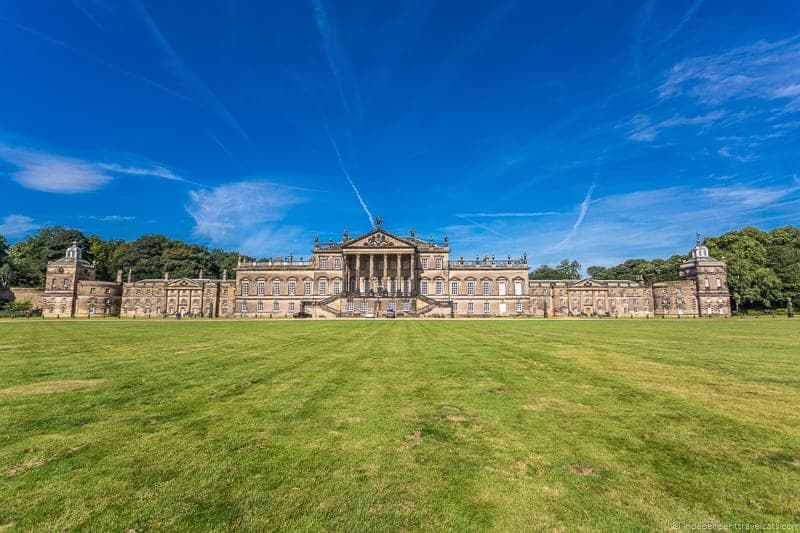
Table of Contents:
How to Visit and Tour Wentworth Woodhouse
Where is Wentworth Woodhouse located?
Address: Wentworth Woodhouse, Wentworth, Rotherham S62 7TQ
Wentworth Woodhouse is located in the town of Wentworth in South Yorkshire in northern England.
The estate is located about 10 miles from Sheffield (~40 min drive), 30 miles from Leeds (~50 min drive), 40 miles from Manchester (~1 hour, 30 min drive), 50 miles from York (~1 hour, 10 min drive), or 170 miles from London (~ 4 hours drive).
How to Get to Wentworth Woodhouse?
You can either drive, take public transportation, or hire a taxi depending on where you are traveling from. If you are flying or taking the train, you can then get to Wentworth Woodhouse via bus or taxi.
If you are driving, there is free on-site parking available at Wentworth Woodhouse for visitors in a paved area near the house. The entrance is accessed off Corthworth Lane (directly opposite the end of Clayfield Lane). Then you’ll drive down the driveway and follow signs to the Visitor Parking area. There is also disabled parking available next to the house entrance for Blue Badge holders visiting the house.
There are regular bus services to the village of Wentworth from nearby towns and villages. It is about a 10 to 20 minute walk from the village bus stops to Wentworth Woodhouse depending on the bus stop.
There is no train station in Wentworth, but you should be able to connect via bus from a nearby train station (e.g., Rotherham, Elescar, Sheffield, Barnsley) to reach the house. You can check public transit connections online here via Traveline.
If you are flying, Leeds Bradford Airport is the closest airport (about a 1 hour and 10 minute drive) but has limited flight connections. The nearest major airport is Manchester Airport and it is about a 1 hour, 45 minute drive from Manchester to Wentworth Woodhouse.
How to Visit Wentworth Woodhouse?
The main way to visit Wentworth Woodhouse is to book a guided tour. Self-guided tours were also recently introduced and you can explore the house and gardens at your own pace.
It is recommended that you book your tour tickets in advance, especially for the guided tours as they limit the numbers on each tour. But you can also book tickets on site.
Other special events also regularly take place at Wentworth Woodhouse including festivals, car shows, lectures, music events in the gardens, holiday festivities, and more. However, these types of events often include limited access to the house.
Cost of Tours at Wentworth Woodhouse?
There are generally several guided tours of the house offered each day. The primary tour, the Wentworth Tour which visiting the main rooms of the house, is currently priced (as of October 2021) at £22 per adult (age 18+) and £12.50 per child (age 5-17).
A number of additional specialty tours are also offered and these tours range in prices. They generally cost between £25 and £50 per adult and between £13 and £25 per child.
Self-guided visits to the house and gardens are currently priced (as of October 2021) at £10 per adult (age 18+) and £5 per child (age 5-17). Admission to the gardens only is £6.00 for adults and £3.00 for children. Family tickets are also available.
Children under age 5 can visit for free with an accompanying adult for most tours and events.
National Trust Members (England, Wales, Northern Ireland) save 50% on admission prices.
What Wentworth Woodhouse Tours are Offered?
The main tour is the Wentworth Tour that covers the history of the family and house and visits the main rooms of the house. But there are several additional tours available as well that you can take, and these tours change regularly.
Here is a list of some of the recent tours that have been offered:
- Wentworth Tour: the primary house tour that covers the history of the house and the people who lived in it, and includes visits to the principal rooms in the house. This is the tour that is recommended for first-time visitors to the house.
- Conservation Tour – a tour focused on the restoration and conservation of the house, including past work, current work, and future projects. Visitors will be taken to see current conservation work in action.
- Black Diamonds Tour – a tour of the house based on Catherine Bailey’s book, Black Diamonds, and a tour path that was designed in conjunction with the author
- Bob’s Tour – a tour with former Fitzwilliam employee and long time tour guide Bob who worked as a local carpenter and joiner. Our first tour of the house was with Bob.
- Hidden Tour – a tour that focuses on parts of the house not normally open to the public
- Garden Tour – a guided tour of the Wentworth gardens with the head gardener
- Lady Mabel Tour – a guided tour that focuses on the house’s time as a women’s teacher training phyiscal education college led by former students of the college
- Stables Tour – a guided tour focused on the large Georgian stableblock and riding school
Wentworth Tours are approximately 1 hour long. Most of the guided specialty tours last between 60 to 90 minutes.
All tours include access to the gardens, which you can visit on your own after the tour. You can also take the self-guided tour once you have done your main tour if you wish to revisit any of the main rooms So be sure to leave some extra time.
How do I Book a Tour of Wentworth Woodhouse?
You can book a tour online, by phone by calling 01226 749639, or by booking on-site at the ticket booth at Wentworth Woodhouse.
It is recommended that you book your tickets in advance, especially for the guided tours as they limit the numbers on each tour and they do often sell out for certain time slots. But you can also book tickets on-site on the day of your visit.
Other Events at Wentworth Woodhouse?
Special events regularly take place at Wentworth Woodhouse including festivals, car shows, lectures, music events in the gardens, holiday festivities, children’s events, film screenings, and more. You can check the events calender to see what is happening and to book tickets for these special events.
The house also welcomes corporate groups, weddings, parties, and other groups who would like to hold an event at Wentworth Woodhouse. You’ll want to get in touch with the events staff at Wentworth to get details.
Accessibility at Wentworth Woodhouse?
The main entrance of the house has 4 steps, but there is an access ramp available (it is advised that visitors call in advance if needing use of the ramp). The ticket area, gift shop, and tea room are all on ground floor and are accessible. Accessible toilets are available. Guide dogs are welcome in the house and gardens.
Only parts of the house are not wheelchair accessible due to the historical nature of the house. The upper floors of the house can currently only be accessed by two flights of stairs.
Most areas of the garden are accessible to wheelchairs and electric scooters although paths can be a bit uneven and muddy. Staff are happy to advise on the best paths.
There is a Disabled Parking area for Blue Badge holders in front of the house. Visitors may also drop off those with restricted mobility near the main entrance.
If you or someone you are traveling with has a physical mobility issue or disability, I would recommend calling in advance to see what type of tour might be best and make any necessary arrangements.
Are Dogs Allowed at Wentworth Woodhouse?
Dogs are not allowed on tours or in most parts of Wentworth Woodhouse. However, well-behaved dogs on leads are welcome in the gardens and in a dedicated area of the house tea room. Guide dogs are welcome throughout the house and gardens.
In the wider Wentworth Estate, dogs are permitted on the public footpaths as long as they are kept on leads.
Is Photography Allowed at Wentworth Woodhouse?
Yes, personal photography is allowed in the house and gardens. Commercial photography is only allowed with written permission and authorization.
Eating at Wentworth Woodhouse?
There is a tea room in the ground floor of the house that serves light meals, sandwiches, cakes, snacks, tea, and coffee. There is also usually a food kiosk open in the gardens serving sandwiches, snacks, drinks, and ice cream. Visitors are also permitted to have picnics in the gardens.
Afternoon tea is often available (need to book in advance) and is normally served upstairs in the Long Gallery.
There are also cafes and pubs located nearby in the village of Wentworth.
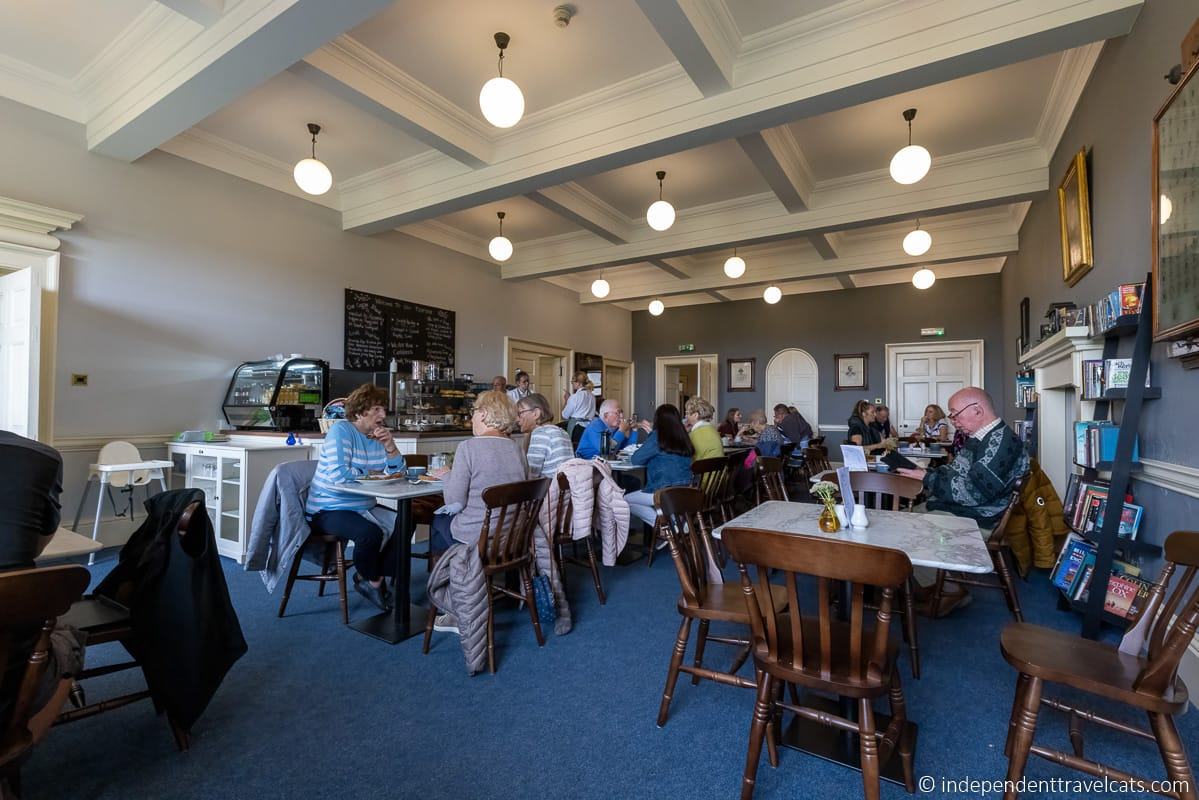
Can I Visit Wentworth Woodhouse without booking a tour?
Yes and no. You can’t visit the house, its interior, or the private gardens without a tour, so you’ll want to book a guided or self-guided tour if you want to go inside the house. But you are welcome to explore sections of the vast Wentworth Estate on your own for free.
It should be noted that the house, stables, gardens, and lawns immediately surrounding the house is owned by the Wentworth Woodhouse Preservation Trust (WWPT). However, the rest of the land (the vast estate) is owned and managed by the Fitzwilliam Wentworth Amenity Trust. This includes the bulk of the village, the historic parkland, and a number of buildings, memorials, and follies.
There are various trails and paths open to the public that go through the village and deer park. The most popular trail is probably the long-distance Trans Pennine Trail which passes through the deer park and offers a good view of the eastern front of Wentworth Woodhouse. Dogs are allowed on the estate but must be kept on a lead.
There are also several monuments and follies in the parkland that can be seen and some of the interiors (such as those of Rockingham Mausoleum) can sometimes be visited on certain days. Seasonal fishing in the ponds and lakes on the property is also possible with a permit. Check online for more information about visiting the Wentworth Estate, which is still overseen by Fitzwilliam descendants.
Can I Spend the Night at Wentworth Woodhouse?
No, currently there are no accommodation options available at Wentworth Woodhouse. However, the Trust does plan to restore, decorate and open up a small section of the mansion as holiday lets or as a bed-and-breakfast in the future.
If you want to stay within walking distance of Wentworth Woodhouse, the Rockingham Arms in the village is only about a 15 minute walk away.
Hotels near Wentworth Woodhouse?
There are only a couple of options in Wentworth itself, but there are a lot of accommodation options in nearby villages and towns. These vary from budget hotels and B&Bs to luxury country house hotels. You can check out available options here.
Here are a few options within a 10 mile drive of Wentworth Woodhouse:
- Rockingham Arms in Wentworth – This small inn offers rooms within Wentworth village with free parking and meals available at the pub located on-site. Bus stop is located just next to hotel. Located within a 15 minute walk from Wentworth Woodhouse.
- Whitley Hall Hotel in Chapeltown – This 4-star luxury hotel is situated in a 16th-century mansion surrounded by gardens, and offers an on-site bar and restaurant and free parking. Located about 3 miles from Wentworth Woodhouse.
- The Fitzwilliam Arms Hotel in Rotherham – This 3-star hotel offers free parking and an on-site bar and restaurant. Note that this place can be noisy on nights that it is hosting events. Located about 4 miles from Wentworth Woodhouse.
- Best Western Plus Pastures Hotel in Doncaster – This 3-star hotel offers modern rooms, an on-site bar and restaurant, and free parking. Located about 7 miles from Wentworth Woodhouse.
- Holiday Inn Express in Sheffield – This 3-star hotel offers modern rooms, flat-screen TVs, an on-site bar and restaurant, free breakfast, and free access to an adjacent fitness room and sauna. There is a small charge for parking. Located within walking distance of Sheffield central city center attractions. Located about 7 miles from Wentworth Woodhouse.
- Hellaby Hall in Hellaby – This 4-star hotel offers guests large comfortable rooms, an on-site bar and restaurant, a spa, a gym, a leisure center, and free parking. Some of the rooms are located in the 17th-century manor house and the rest are located in a modern part of the hotel. Located about 8 miles from Wentworth Woodhouse.
If you are looking for a self-catering apartment or holiday home, you can check listings on VRBO, listings on Booking, and listings on Plum Guide for options in the area. You can also see this guide to booking holiday homes in the UK and Ireland for more options.
How to Find out more Information about Wentworth Woodhouse?
To find out more information about visiting the house, you can explore their official website or give them a call.
If you want to learn more about this intriguing house and its inhabitants, there are a number of books about Wentworth Woodhouse that you can read. I can personally recommend the informative but entertaining book Black Diamonds: The Rise and Fall of an English Dynasty by Catherine Bailey. I read this book back when it came out and it is the book that initially got me interested in exploring Wentworth Woodhouse.
The book not only provides a good history of the house and family, but gives a good insight into the British coal industry, the tough lives of the families that lived in the pit villages, and the divisive class struggles that took place in 19th and 20th century England.
Other books recommended by Wentworth Woodhouse staff include The Country House Revealed (2011) by Dan Cruickshank (BBC also turned this into a 6-part miniseries with one episode devoted to Wentworth Woodhouse), Wentworth Woodhouse: The House, the Estate, and The Family (2021), and their own Wentworth Woodhouse guide book (sold in their gift shop).
Other Nearby Places to Visit with a Wentworth Connection?
You can easily spend a day or two in the area visiting places connected to the Wentworth family and Wentworth Woodhouse.
The easiest to explore is the wider Wentworth Estate. I would definitely encourage you to allow extra time to walk around and explore the Wentworth Estate with its large amount of parkland, lakes, and interesting follies. Just be sure to stay on the public footpaths. Dogs are permitted if kept on a lead at all times.
The village of Wentworth is also an easy place to explore on foot before or after a visit to Wentworth Woodhouse. Here you’ll find a couple of pubs, inns, the Village Shop, and the village’s two Holy Trinity Churches (both built or rebuilt by the Wentworth family). Many members of the Wentworth and Wentworth-Fitzwilliam family are buried in the churchyards here.
Next door to Wentworth Woodhouse you’ll find the Wentworth Garden Centre, which is set within the historical kitchen garden and pleasure garden of Wentworth Woodhouse and you can still see the walled garden here. So a great place to stop if you have time.
Nearby, you might also want to visit Wentworth Castle which was owned by a separate line of the family. The castle itself is not typically open to the public, but the gardens and parkland are often open.
The Elsecar Heritage Village is a conservation village with craft workshops and local businesses. Elsecar was once a booming center of coalmining and ironmaking built and owned by the Wentworth family. Men worked here from the late 18th century until the 1980s. It is also the site of a Newcomen steam engine which is the oldest steam engine in the world still in its original place.
In 1912, King George V, when staying at Wentworth Woodhouse, would make a descent by cage into Elsecar Main Colliery, the first time a British monarch entered a coal mine. If you visit Elsecar, we recommend heading to the visitor center for information and then you can follow a path around to learn more about the historical colliery, ironworks, workshops, and railway station.
The National Coal Mining Museum in Wakefield (about 40 minutes drive from Wentworth) is a museum that tells the history of coal mining in England and is built on the site of a former colliery. You can visit the interactive museum and take a guided tour underground to better understand what it was like to work in a coal mine.
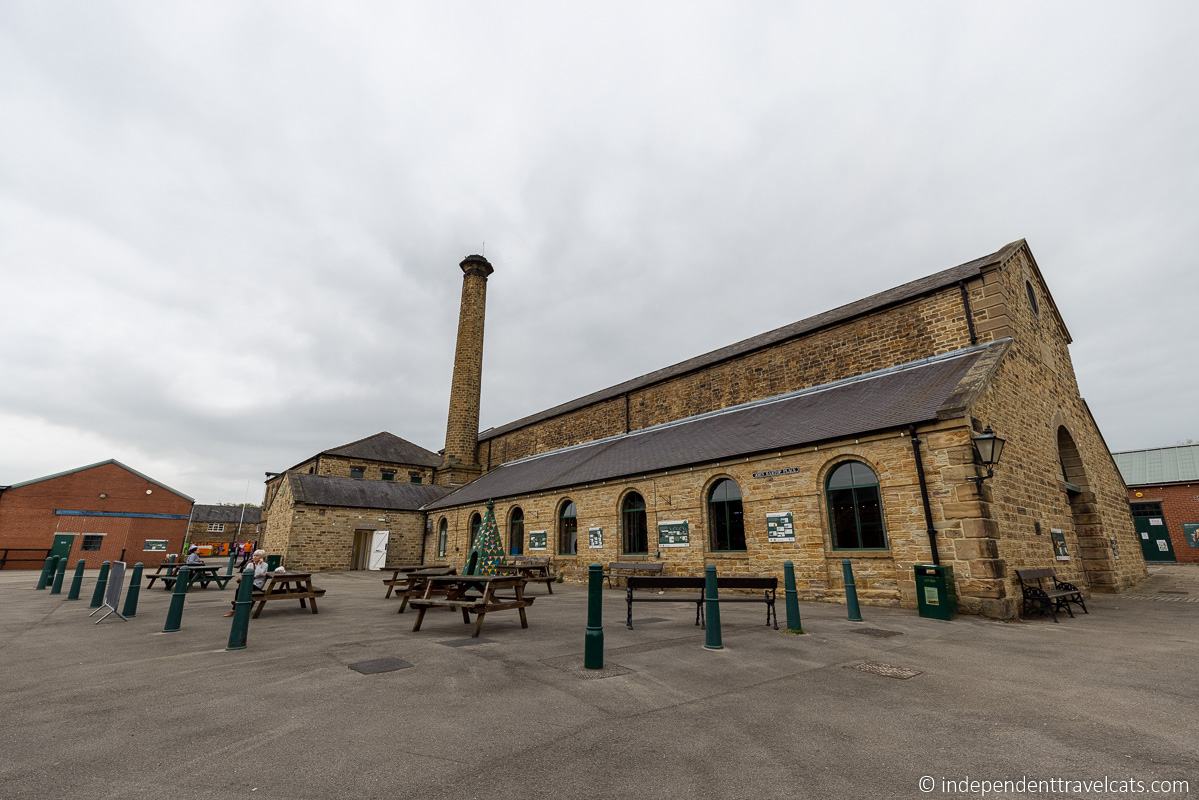
A Brief History of Wentworth Woodhouse
The house we see today can actually be thought of as three separate houses. The original house was built here for Thomas Wentworth, the 1st Earl of Stafford, in the 1630s. Thomas Wentworth was an advisor to King Charles I and was famously executed in 1641. The house and land passed down to his son after his death. Very little of the original house can be seen today.
Later, it would be Thomas Watson-Wentworth, 1st Marquess of Rockingham, who would have the original Jacobean house rebuilt and expanded in the 1720’s in the Baroque style (this is the red brick part of the house). The English Baroque style West Front was built from about 1725-1734.
This was obviously not big or grand enough for the Wentworths who felt the Baroque style was now out of fashion, and plans were soon drawn up for an entirely new eastern wing of the house to be built in the Palladian style back-to-back with the Baroque wing. This is the part of the house that can be seen from the park and is made from sandstone. The Palladian East Front of the house was started before the West Front was even finished.
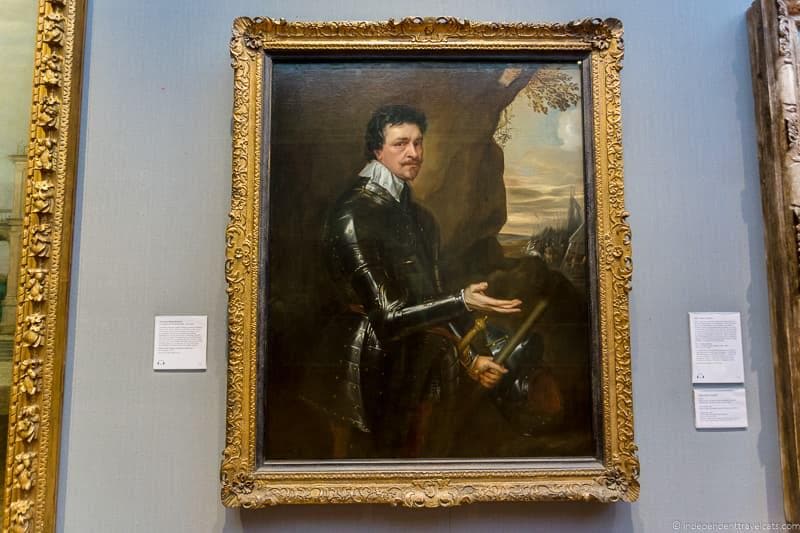
Throughout the 18th century, the house would continue to be expanded by Thomas Watson Wentworth and his son Charles Watson-Wentworth. Architects who worked on the house included possibly Inigo Jones (17th century gateway is attributed to him), Ralph Tunnicliffe (English Baroque addition), Henry Flitcroft (Palladian West front), and John Carr (additions to Palladian West front and building of the stables and numerous estate buildings and follies).
Wentworth Woodhouse would soon become the largest private home in England (and would remain so until 2017!). As a leading Whig grandee, Charles Watson-Wentworth would use the grand house as a showplace for Whig power.
The Heyday of Wentworth Woodhouse
The house and its contents would soon pass down into the Fitzwilliam family, related by marriage, who would own the house from 1782 to 1989. By the end of the 18th century, the wealth of the family would greatly increase thanks to the discovery of vast amounts of coal from the rich Barnsley seam on their South Yorkshire land.
Although involved in several industries (e.g., iron, agriculture, pottery), it would be coal that would make the Fitzwilliam family one of the wealthiest families in England. Money was no object for this family who furnished the 300+ room house elaborately, employed about 1,000 staff members on the estate, and hosted important political figures, aristocracy, and royalty. At the death of the 6th Earl in 1902, the family’s fortune is estimated to be equivalent to £3 billion.
If you’ve seen Downton Abbey, the fictional Crawley family would have had nothing on the real-life Fitzwilliams in their heyday. In fact, it would be the 1912 royal visit of King George V and Queen Mary that would inspire the main plotline of the 2019 film Downton Abbey, and indeed Wentworth Woodhouse was used as a filming location in the movie. (The main filming location for the show and film is Highclere Castle.)
The Decline of Wentworth Woodhouse
However, less than 50 years later, the downfall of the house and the family would come in the 1940’s. Two sets of death duties and the nationalization of the coal mines would reduce the wealth of the family. To pay the death duties, the family would sell off many pieces of valuable art, furniture, and artifacts.
After the Second World War, coal was badly needed in a depressed England and there were severe shortages due to a decreased workforce and increased need. The government, specifically the Minister of Fuel and Power Manny Shinwell, who had a personal animosity against the wealthy aristocracy, ordered for the gardens of Wentworth Woodhouse to be dug up for opencast coal mining.
Although the Fitzwilliams and many others who did not want to see the gardens and house destroyed fought against the decision, the estate would become one of the largest opencast mining sites in Britain. The mining would destroy the gardens and the machines dug within feet of the house itself. In time, more than 132,000 tons of coal were dug out of the gardens and this digging would eventually lead to foundational issues of the stately home.
Perhaps the final important event in the downfall of the house and family was the unexpected death of Peter, the 8th Earl of Fitzwilliam. He would die along with his lover Kathleen Kennedy, sister of future President John F. Kennedy, in 1948. He left no male heir, so the house was passed to a much older second cousin with no children.
After the 8th Earl’s death, the family would soon turn the house over for use as an educational facility. It would be leased by the Lady Mabel College of Further Education and then Sheffield City Polytechnic until 1988. During this period, the Fitzwilliam family would still retain a suite of rooms and staff for private living use.
In 1989, the Fitzwilliams would sell the house & around 90 acres of land, but they retained control over the vast park and many of the artistic treasures taken from the house. The buyer was Wensley Haydon-Baillie, an infamous English businessman whose financial situation would steeply decline in the 1990s.
In 1999, the house was bought by Clifford Newbold, who as an architect wanted to fix up the house as a retirement project and to open it back up to the public. He also had plans to convert parts of the house into a museum, a hotel, and an events venue. Newbold bought the house for only £1.5 million as although there was a lot of interest in the house, there were few serious buyers.
In 2012, Wentworth Woodhouse would be opened for the first time for public tours. Clifford Newbold would die in 2015 and the house would be put back on the market. It would be the Newbold family who would be largely responsible for opening up the house to the public, seeking reparations from the Coal Authority for the damage from the opencast mining, and fighting for the future preservation of this house.
The house would remain a private house until 2017 when it was sold by the Newbold family to the Wentworth Woodhouse Preservation Trust.
A New Future for Wentworth Woodhouse
Life is being breathed back into Wentworth Woodhouse once again. Although the house is believed to need at least an estimated £42 million for repairs and restoration, great gains have been made recently.
After a long legal fight with the UK Coal Authority, it was announced in November 2016, that the government would award £7.6 million towards restoration for the damage done by the Labour government after WWII.
In 2017, the house was sold to the Wentworth Woodhouse Preservation Trust for £7 million. The Trust plans to raise funds to restore and preserve the house and keep it open to the public. In 2017, Wentworth Woodhouse Preservation Trust received a grant of £3.5million from the National Heritage Memorial Fund.
In 2017, the National Trust also announced it would be helping to collaborate in preserving the historic home, saying “Our partnership at Wentworth Woodhouse includes financial support over three years and operational support over six years. We’ll be advising on areas such as presentation, visitor services, opening hours, visitor experience, volunteer management and marketing.” The positive impact of the National Trust was definitely visible on our most recent visit.
In 2019, substantial repairs and restoration to the building started, including repairing the roof. Now that the house is watertight, it has allowed for restoration and conservation work to move forward inside the house. Restoration works are likely to continue for many years as long as the Trust has enough funds to keep moving forward with its plans.
In recent years, a lot more visitor events have started taking place at Wentworth Woodhouse, including concerts, classic car shows, author talks, bridal shows, film screenings, fundraising events, afternoon teas, holiday craft markets, etc. There has also been an increase in weddings, corporate events, and other private events.
Based on our two visits in 2016 and then again in 2021, we’ve seen lots of improvements in the facilities and public access areas including the tea room, food options, gift shop, toilets, check-in area, and gardens. There are also a lot more tour options, tons more staff and volunteers, and a much better website.
The Trust has lots of plans of future work and improvements over the house that should hopefully come to fruition over the coming years including a new parking lot, turning the Camelia House into a restaurant, and turning the Stables into an events venue.
The house has a long road ahead as it is in great need of substantial repairs but it looks like it will be saved and preserved for future generations of visitors!
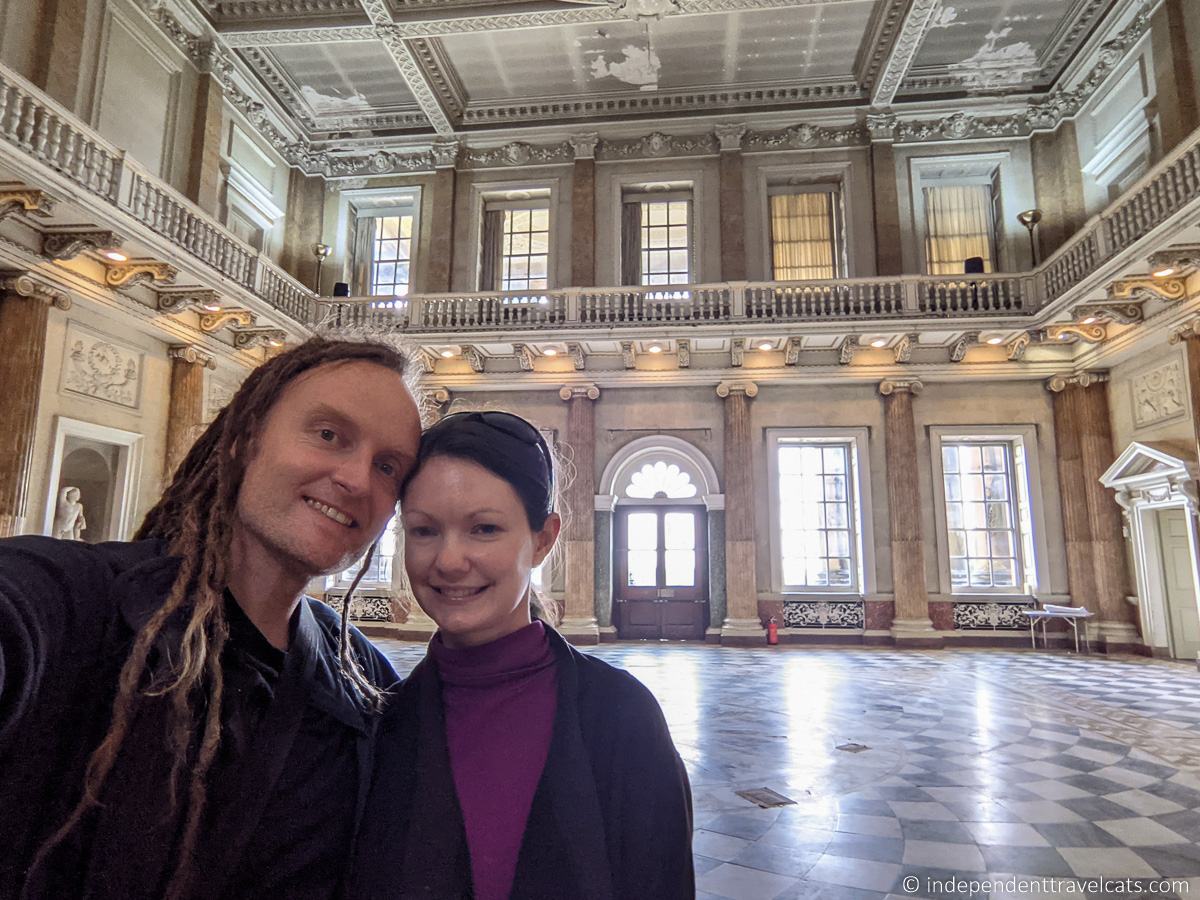
Interesting Facts about Wentworth Woodhouse
I loved learning about the history of Wentworth Woodhouse and the aristocratic families who lived here: the Wentworths, Watsons & Fitzwilliams. These are some interesting pieces of information we learned either during the tour, from reading Black Diamonds, or from other research.
- The Wentworth family have owned land around the village of Wentworth since the 13th century, but the first known house here was built by Thomas Wentworth, the 1st Earl of Stafford, in the 1630s. The ill-fated Earl gained significant power as an advisor to King Charles I but would be executed in 1641 with consent by the king who wanted to appease the Parliament.
- The Wentworth/Watson/Fitzwilliam family would have a number of inheritance issues and rivalries over the centuries. The first to concern Wentworth Woodhouse was when William Wentworth, 2nd Earl of Strafford, died in 1695. Instead of leaving it to the expected Thomas Wentworth, it went to a cousin Thomas Watson. Thomas Wentworth felt he was the rightful heir to the title and estate, and for generations the two sides of the family would compete for political and social power. This would be one of the reasons for the grandeur of Wentworth Woodhouse and nearby Stainborough Hall (later called Wentworth Castle), which were owned by the separate rival branches of the family.
- Charles Watson-Wentworth, 2nd Marquess of Rockingham, had many follies constructed on the estate in the 18th century that were designed by John Carr. One of these, a 46 ft. tall pyramid shaped folly called Needle’s Eye, is said to have been built for the Marquess to win a bet as he said he could “drive a coach and horses through an eye of a needle”. If you look closely at the folly, you’ll see a number of musket-ball holes at around head height, and it is said that it may have been used as a location for a firing squad.
- In 1771, American statesman Benjamin Franklin would visit the north of England and Midlands, making stops at both Wentworth Woodhouse and Chatsworth.
- A visit to Wentworth Woodhouse by the Prince of Wales and the Duke of York in 1789 helped secure the social reputation of the family. Over 20,000 people congregated on the lawn at the house to witness their visit.
- In 1835, a young Princess Victoria stayed at Wentworth Woodhouse for a few days. She wrote in her diary about the house: “It is a very fine edifice, and is an immense house…it would be impossible for me to attempt even to give anything like a description of it.” She found it large, nicely furnished, and enjoyed exploring the estate. However, she found the custom of the house that the chaplain precedes the party to dinner as “peculiar”.
- In 1841, over 1,000 staff were employed on the estate, working in occupations that included housekeepers, carpenters, gardeners, stablehands, gamekeepers, and even rat catchers. Tens of thousands more would be dependent on the Earl, working in the many coal pits and pit villages owned by the family.
- The 6th Earl Fitzwilliam had eight sons, all called William, and six daughters. At his death in 1902 with so many children and a net worth of 3 billion, it would have been almost impossible to foresee the decline in family fortune and the end of the Earldom by 1979.
- Family secrets and scandal would erupt around the succession of the 7th Earl Fitzwilliam, leading to a legal fight. It was believed that William “Billy” Fitzwilliam, son of the epileptic black sheep of the family Viscount Milton, who was born in a remote Canadian frontier cabin, was illegitimate and family members claimed he was a changeling and had no rights to the family inheritance. Billy Fittzwilliam won the case and inherited the title, but no conclusive evidence was ever produced either way.
- The 7th Earl would modernize the house. In 1904, electricity was first installed at Wentworth Woodhouse and later central heating and running water would also come to the house.
- In 1912 King George V and Queen Mary stayed at Wentworth Woodhouse on a royal visit to Yorkshire to visit local coal villages and collieries. A total of 76 bedrooms were required for the royal visit and tens of thousands of people lined the streets and gathered in the park to see the royals. Special entertainment such as a performance by the Russian ballerina Anna Pavlova was arranged for the king and queen.
- During the 1912 royal visit, King George V would descend into the Elsecar coal pit (one owned by the Fitzwilliams) and did so following a tragic mining disaster at nearby Cadeby Colliery which killed 91 men. While the Fitzwilliams were generally seen as responsible and respected owners for the time, the terrible conditions of collieries and pit villages in general would lead to intense criticism and a perceived need for nationalization.
- During World War II, Wentworth Woodhouse was used by the military, primarily the Intelligence Corps. They occupied the stable block and parts of the main house. Floorboards would be put down to cover marble floors, dust sheets would cover the furniture, art and personal objects packed away, and rooms would be padlocked to create storage areas for the family’s belongings. In 1944, Peter Wentworth-Fitzwilliam, the 8th Earl Fitzwilliam, was awarded a Distinguished Service Order for his courage during service in World War II.
- Following WWII, the government ordered opencast mining in the gardens next to Wentworth Woodhouse. The mining would ruin the gardens and make it very difficult for the family to live in the home, and eventually it would lead to the house’s having foundational issues.
- The 8th Earl was well known for his drinking, gambling, and womanizing, and he was rumored to have fathered a few illegitimate children with local women of the pit villages. In 1946 Peter Wentworth began a romantic affair with the widowed American Kathleen “Kick” Cavendish, Marchioness of Hartington, sister of future U.S. President John F. Kennedy. Peter Wentworth-Fitzwilliam and Kathleen were killed in a plane crash during a thunderstorm in France in 1949. At the time, the powerful Kennedy, Fitzwilliam, and Cavendish families closed ranks to obscure the nature of their relationship in the press to avoid scandal.
- In 1949 following the death of the 8th Earl Fitzwilliam, the family sold a significant amount of the contents from Wentworth Woodhouse, including a large amount of art and furniture. The family’s financial situation had been reduced after the payment of death duties and the recent loss of profits after the nationalization of coal in 1946.
- The house would then be leased to be used as an educational facility for female physical education by the Wentworth family, a decision championed by Lady Mabel Fitzwilliam, sister of the 7th Earl Fitzwilliam. The Marble Saloon, where Anna Pavlova had danced for King George V, would be used as a gymnasium and the Whistlejacket Room would be used as a dance studio! It would continue to be leased as an educational facility until 1988.
- In 1952, a scandal about legitimacy would rock the family again upon the death of Eric Spencer Wentworth-Fitzwilliam, the 9th Earl Fitzwilliam, who died childless. A cousin, George “Toby” James Charles Wentworth-Fitzwilliam was the next in line to inherit; however, his mother had made claims that he had been born out of wedlock after he chose to marry someone she believed was below his class. These spiteful claims would lead to him losing a court case brought against him by members of his family, and his younger brother “Tom” (William Thomas George Wentworth-Fitzwilliam) would become the 10th Earl Fitzwilliam.
- In 1972, the 10th Earl had tons of family documents and records burned over a period of 3 weeks at the house, destroying vast amounts of information about the family and house. It is not known what information he destroyed or why, but it is speculated that documents related to his brother’s legitimacy may have been included.
- The last Earl Fitzwilliam, the 10th Earl, would die at Wentworth Woodhouse in 1979 without an heir. The title Earl Fitzwilliam is now extinct. The house would be sold by the family in 1989.
- The house was in private hands between 1989 and 2017. The house would remain the largest private home in England until 2017, when the Newbold family moved out and it was sold to the Wentworth Woodhouse Preservation Trust. The Trust owns and manages the house today.
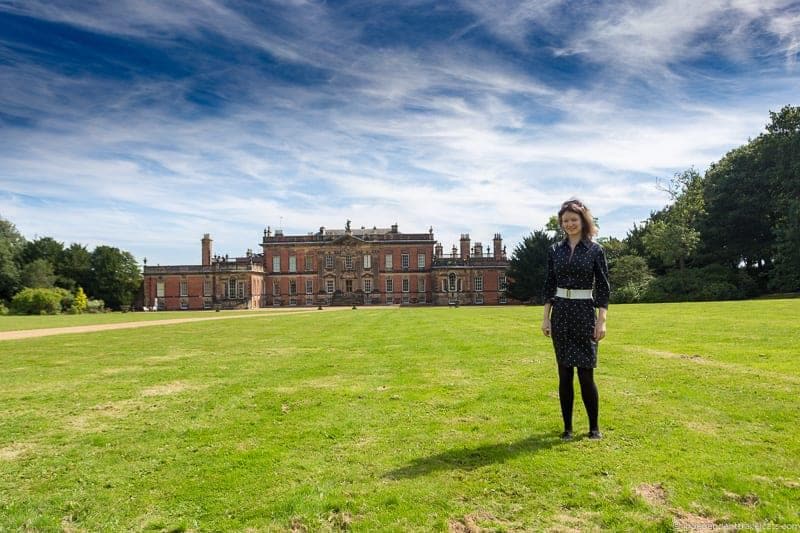
What was Filmed at Wentworth Woodhouse?
Wentworth Woodhouse has appeared in a number of TV shows, movies, and documentaries. TV shows have included British TV miniseries Wives & Daughters and Jonathan Strange & Mr. Norrel and the TV drama series Victoria and Gentlemen Jack. Films have included the award-winning Mr. Turner and Darkest Hour (the Whislejacket Room fills in for Buckingham Palace in this Winston Churchill film).
Probably the most recent notable filming at Wentworth Woodhouse was the 2019 Downton Abbey film. The beautiful Marble Saloon was used as the Harewood House ballroom in the film. Interestingly, the film’s main plot about the king and queen visiting Downton Abbey (which is real-life Highclere Castle) was inspired by the 1912 royal visit of King George V & Queen Mary to Wentworth Woodhouse. Julian Fellowes, the series creator, reported that he read Catherine Bailey’s book Black Diamonds and it helped him decide on the film’s main plotline.
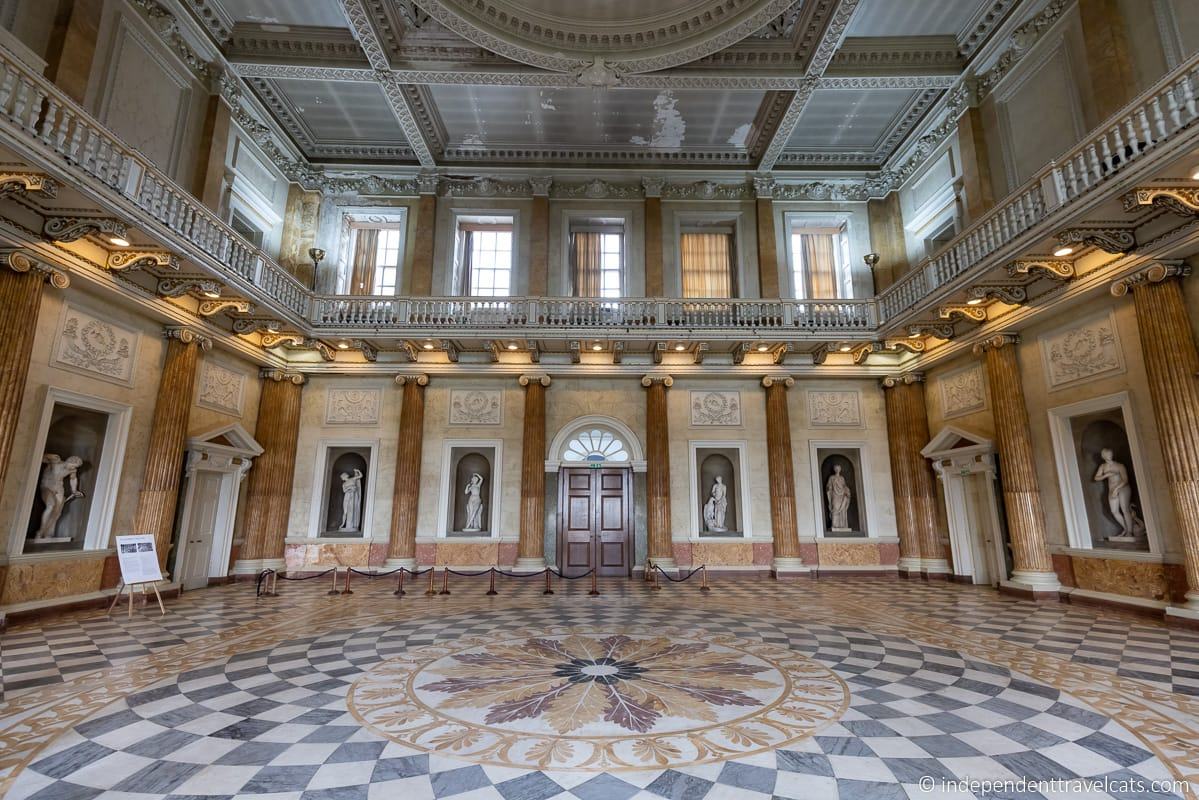
Our Wentworth Woodhouse Tour
Laurence and I have been to Wentworth Woodhouse three times now. The first time in March 2016, we only viewed the house from the park and there weren’t any tours scheduled the day we visited. But we returned later that summer and toured the house for the first time.
The first tour we did was called The Fitzwilliam Tour, which was a 2 hour tour (with a 20 minute break midway) that included the principal rooms of the house plus a guided tour of the gardens. This tour doesn’t exist anymore but is essentially the current Wentworth Tour plus a guided Garden Tour.
Our house guide on that first tour was Robert “Bob” Mortimer, a carpenter and joiner who had worked for the 10th Earl of Fitzwilliam. He has been giving tours for the house since it opened to the public. Bob still gives tours at Wentworth Woodhouse but now has his own tour called Bob’s Tour which is currently the priciest tour option on offer. We were very fortunate to have had such a knowledgeable person on our first visit!
The main house tour includes the principal rooms of the house located in the east wing of the house. The information focuses on the time it was occupied by the Watson, Wentworth, and Fitzwilliam family members, but information was also included about the time the house was used by the Intelligence Corps during the war, its time as an educational institution, and most recently as a private residence for Wensley Haydon-Baillie and the Newbold family.
We returned to Wentworth Woodhouse in September 2021. We did the Black Diamonds tour which is one of their newest tours that lasted about 90 minutes. We booked the tour online in advance and were able to get 50% off for being National Trust members. The tour included the principal rooms of the house plus some of the areas not currently opened to the public but which were mentioned in Bailey’s book. With our tour ticket, we also got free access to the garden and we visited there after our tour.
So much had changed between our two visits, and almost all of it in a good way. Everything from the parking lot location, tour booking, tea rooms, photography policy (photography was not allowed until 2018), tour experience, gift shop, etc have changed. Both funding and time have really had a positive impact here.
On our first visit to Wentworth Woodhouse in 2016, there were only about 10 of us on that tour and there were only a few staff members in the house. At that time, the tea room/gift shop offered only tea, coffee, and packaged snacks and a few of their own printed guidebooks for sale. Back in 2016, the house was still a private residence with the Newbold family still in residence.
So it was a pleasant surprise to see so many people in the house (both visitors and staff) at the house during our recent visit in 2021. Also the expanded tea room, new gift shop, and new guest check-in areas had grown and improved so much compared to what they were in 2016. Perhaps one of the biggest changes (although not as visible) was that the house roof has been repaired and the house is now watertight (there had been leaks during our first visit and structural concerns).
Clearly, lots of changes have been made, first by the Newbolds and now by the Wentworth Woodhouse Preservation Trust. The Trust has a long list of future renovations and changes planned. We are excited to see how things continue to change in the future and that more of the house is opened up and put to use, both for the local community and for visitors.
Since we’ve been a few times now and done different tours, we’ll just talk generally about our visits and the different areas of the house that you can visit here.
Wentworth Woodhouse Palladian Exterior
Instead of going straight into the house, we recommend walking around the front lawn a bit to take in the house. You are looking at the Palladian east front of the house. This section of the house is made of sandstone and was designed by architect Henry Flitcroft with later additions by John Carr.
Wentworth Woodhouse was the largest private home in the UK until it was sold to the Trust in 2017. It has the longest façade of any country home in Europe at over 600 feet in length. It is more than twice the length of Buckingham Palace; the physical footprint of the house is enormous!
If you are taking a photo, you need to be quite a distance away from the house to get it all in. As we stood in front of the Palladian east front of the house, we were struck again by the immense size and length of the house!
The main entrance and exit for the house is here and this is where you’ll go to check-in, get tickets, etc.

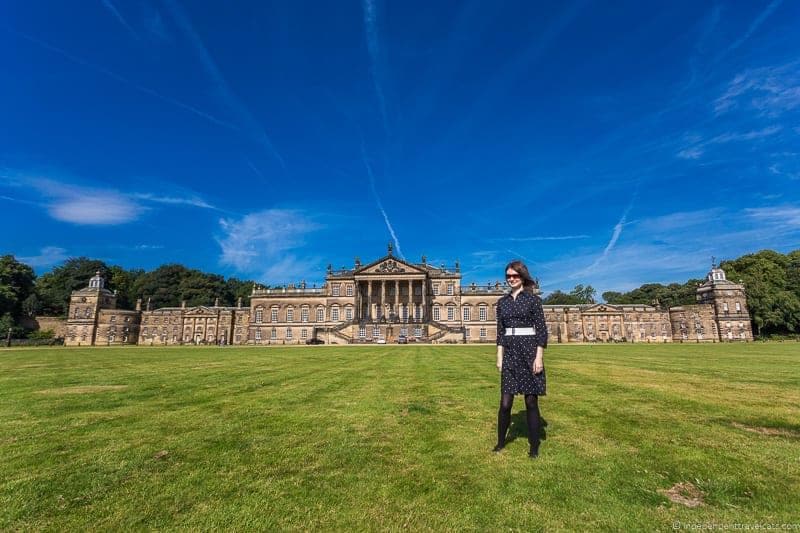
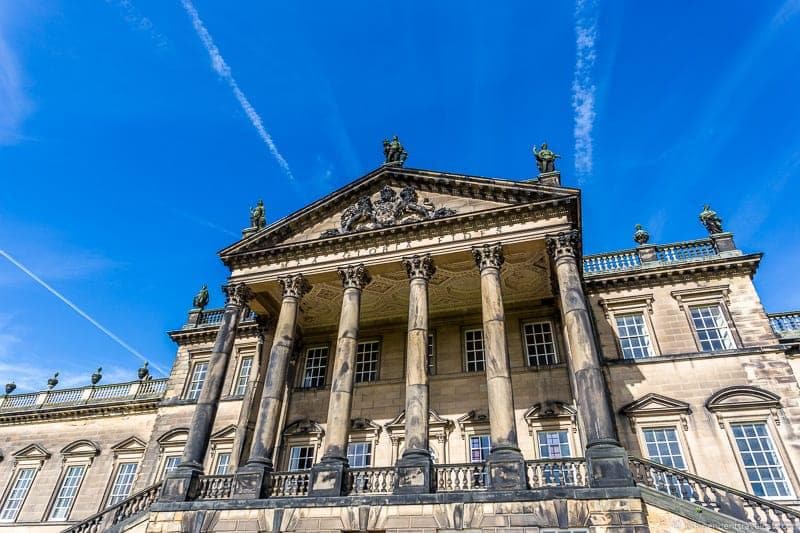
Wentworth Woodhouse Rooms
We were very excited to finally get to see inside the house. After you enter the house, you’ll find the check-in and ticketing area and an information booth. This is where you can check-in for your tour, buy tickets, get a map of the gardens, sign up to become a member, ask questions, etc.
After checking in, you’ll find yourself immediately within the grand entrance hall. Known as the Pillared Hall, it is a grand foyer filled with a forest of pillars and neoclassical statues, leading to the main staircase. Here we got our first look at both the grandeur and immense size of this house.
The tours generally all start here in the Pillared Lobby so you’ll meet your guide here. Or if you are doing an unguided tour, you will show your ticket and be directed to begin the self-guided route of the house and/or gardens.
No matter what tour you take, you will only see a relatively small number of the rooms of the house given the massive size of this house. The house is said to have about 365 rooms and five miles of passageways!
On our first tour, a guest asked Bob about the exact number of rooms, and he explained that is very difficult to give an exact count but noted that there are over 300 rooms. He explained that not only would it take a lot of time to try to count them all, but it is hard to classify what is a “room” given that there are anterooms, storage spaces and cupboards bigger than bedrooms, giant corridors filled with furniture and artwork, and the like. This helps explains the large discrepancy in the room count for the house given by different sources.
Even Princess Victoria during her 1835 visit couldn’t help but keep noting the “immense” size of the house despite growing up in a palace and being a guest at all the large country houses. As we made our way through a confusing series of rooms, it is easy to see how guests of the family would have gotten lost in the house!
In fact, Catherine Bailey notes that getting lost was a common problem for guests at Wentworth Woodhouse. She wrote that “One guest, a Baron von Liebig, resorted to crumbling wafers along the route from his bedroom to the dining room so that he could find his way back after dinner. Thereafter, guests were presented with a crested silver casket containing different-coloured confetti.” It is interesting to imagine aristocratic guests leaving bread or confetti trails as they made their way from the dining room and Marble Saloon to their bedrooms!
So depending on the tour you choose, you may see slightly different rooms in the house and the tour circuit has changed over time. But if you choose the Wentworth Tour, Bob’s Tour, or the self-guided tour, you’ll be seeing the principal rooms of the house. These are some of the most impressive and restored rooms in the house. But other guided tours explore some of the other areas of the house.
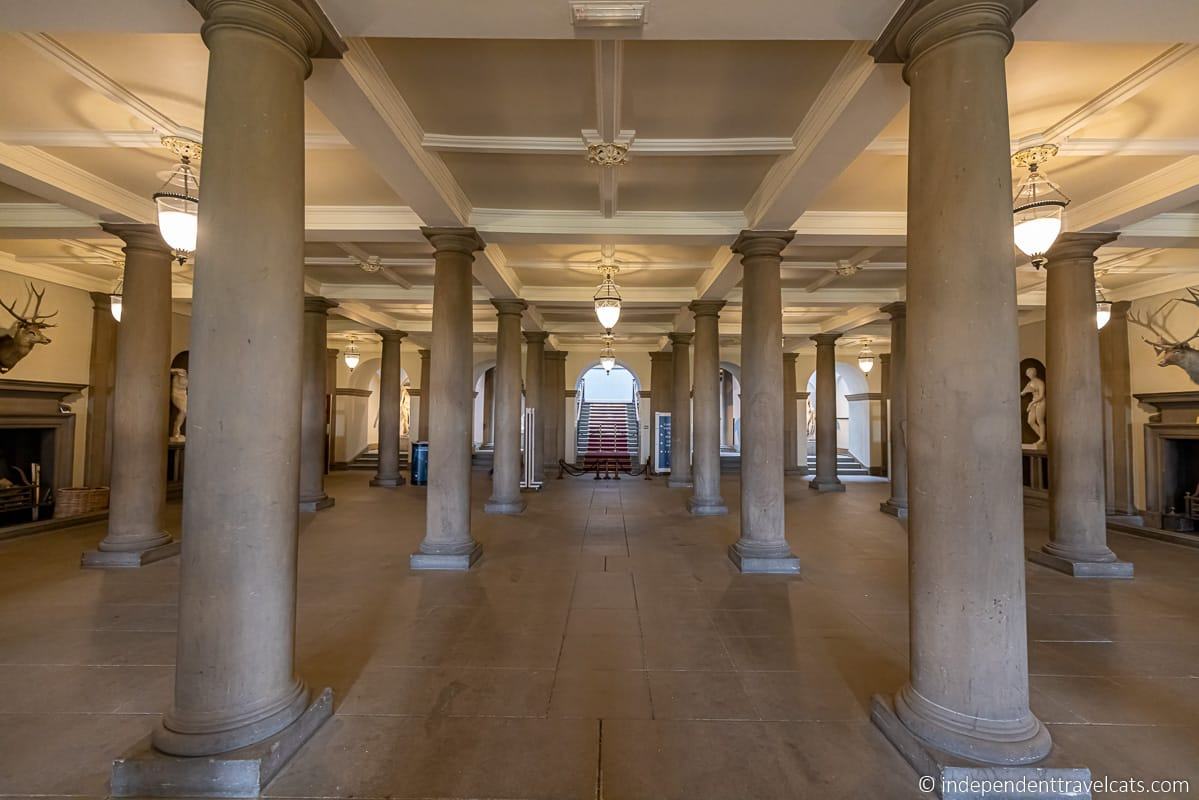
State Rooms
The so-called principal rooms of the house or State Rooms are the main public rooms in the house located in the east wing of the house. These rooms are spread over two floors.
The first room on most tours includes a model of the house and a short talk about the house’s architecture and layout of the house over the years. This is a helpful orientation to the house to get you started.
Like the exterior of the house, the interior decorative and architecture styles are mixed as you move around the house from Rococo to neoclassical. As mentioned earlier, the house is massive and no matter what tour you take you’ll only get to see a portion of the rooms.
Some of the tour highlights, which are included on the Wentworth Tours, are the Pillared Hall, staircase, Marble Saloon, Whistlejacket Room, Van Dyck Room, and the family chapel. The Long Gallery (if open, it is used for afternoon tea and events) is also a lovely room.
The most famous room in the house is probably the Marble Saloon (a.k.a. the Marble Hall). This 60 ft. square grand room is 40 ft. high and was designed in the Georgian style. The ceiling plasterwork by Jonathan and Joseph Rose is an impressive work of art and is reflected in the design of the multi-colored patterned marble floor. This perfectly proportioned room is surrounded by statues along the ground floor.
The Marble Saloon is the grandest entertaining room in the house and was used for balls and performances. Laurence and I had a little dance in the rooms ourselves although I don’t think our dancing skills are quite on par with Anna Pavlova who once danced in the room during the royal visit of King George V & Queen Mary in 1912.
This grand room would be covered with wood when the military arrived during World War 2 and then soon after was used by the women’s physical education college as a gymnasium! As Bailey writes, this grand room was “filled with climbing ropes, vaulting horses and balancing beams”. There is definitely damage from its time as a gymnasium, but not nearly as much as we would have imagined.
During our tour, we were able to see both the grand scale of the house and imagine its past grandeur as well as get a sense of the need for restoration. It is likely that more rooms will open to the public in the near future as repairs and restoration work are done to the house. Some rooms during our visit had been recently repaired and decorated to be used for TV or movie filming.
One of the things that may be striking is how little furniture and art is currently in the house. The house once contained a priceless art collection containing a number of works by Titian, Van Dyck, and Raphael.
While there are a few pieces of decor as well as a number of statues that are still in the house, most of the original art was removed by the family after World War II. It is now held in private collections or is on display at museums. Lady Juliet Tadgell, daughter of the 8th Earl Fitzwilliam, inherited a large amount of the art and it remains in her private collection.
Perhaps one of the most famous pieces of artwork associated with the house is the life-sized painting of the horse Whistlejacket by George Stubbs. The painting of the family’s Arabian racehorse was commissioned by Charles Watson-Wentworth, and is regarded as one of Stubbs’ finest equine paintings. The immense painting hung in the Whistlejacket Room but today there is only a copy at the house as the original now hangs in the National Gallery in London.
Our guide Bob explained to us that at the current time, given the need for house repairs and the money need to insure and preserve the artwork, it is not feasible for the art to be maintained at the house. However, it is hoped in the future that some of the original pieces could be loaned or donated back to the house.
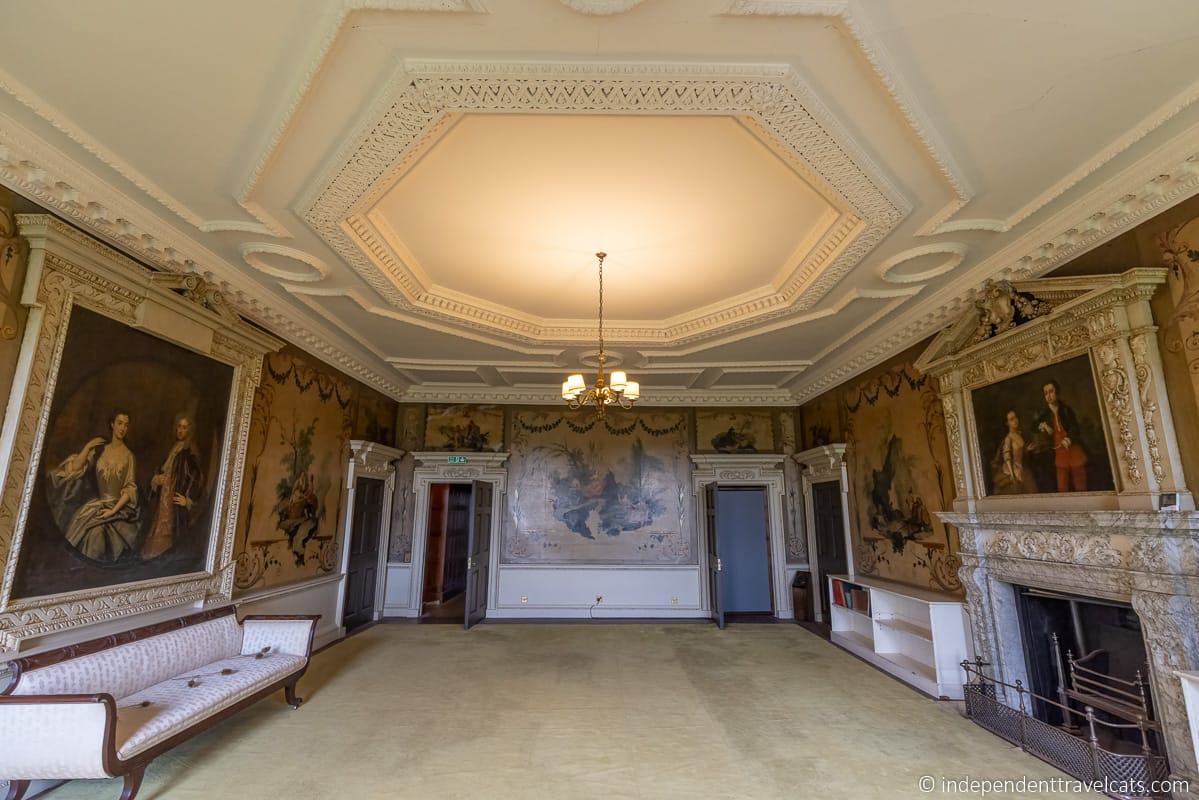
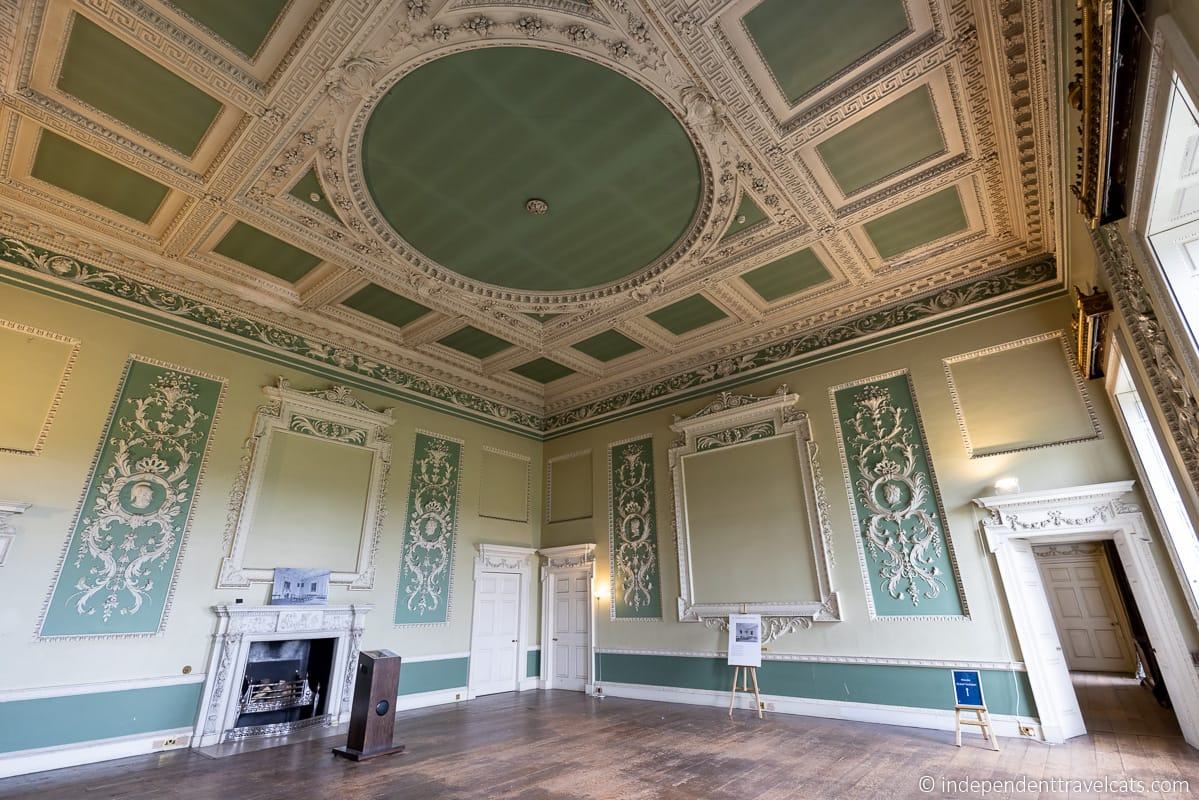
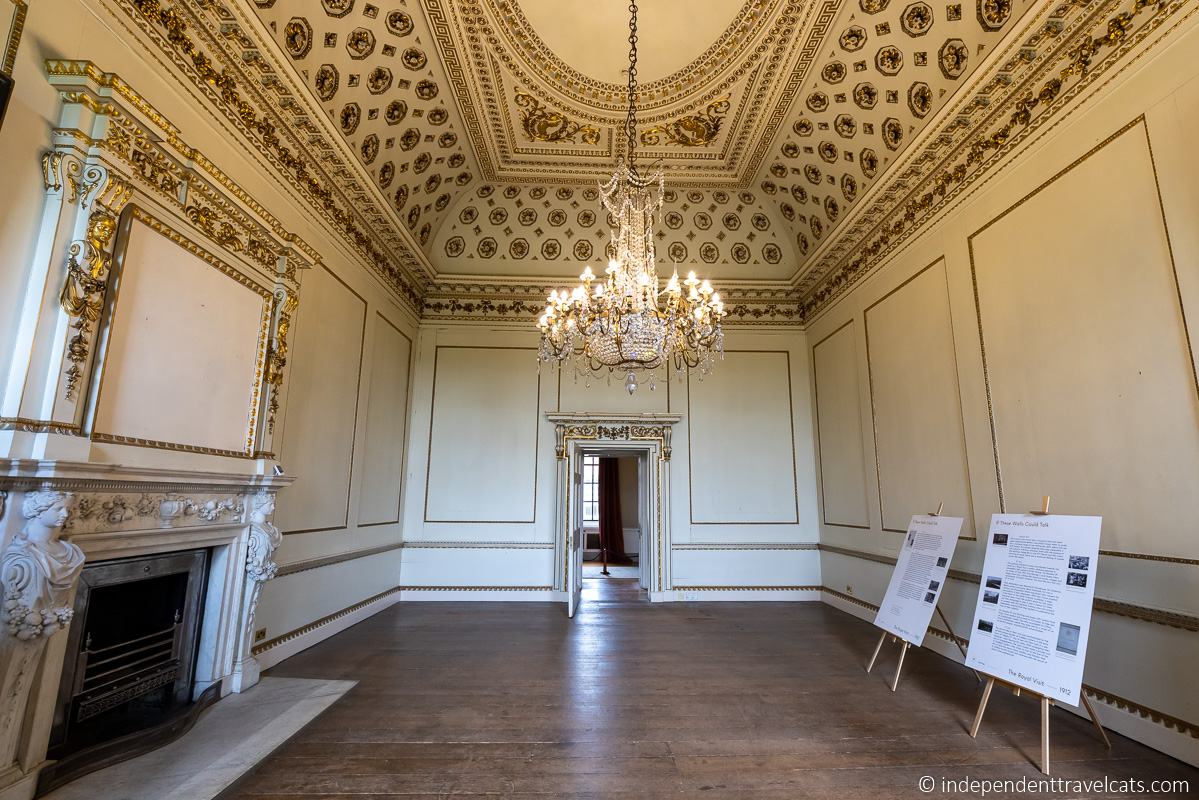
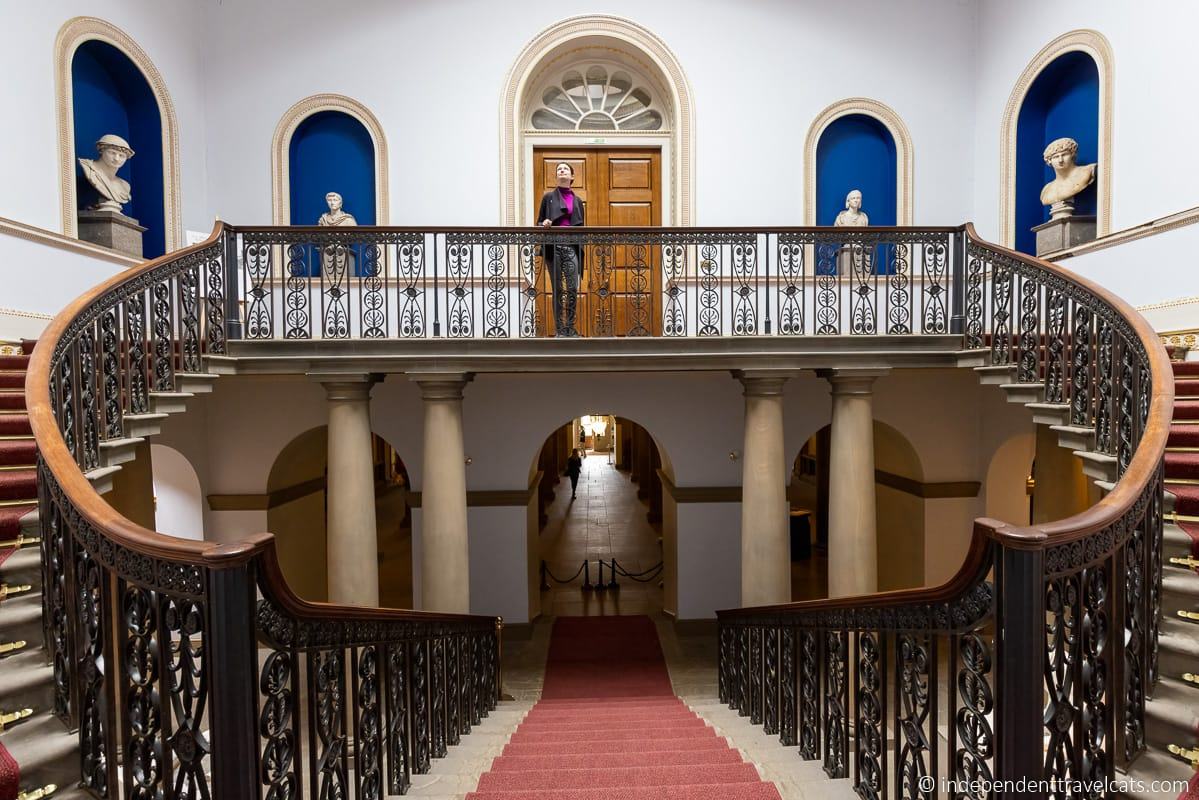
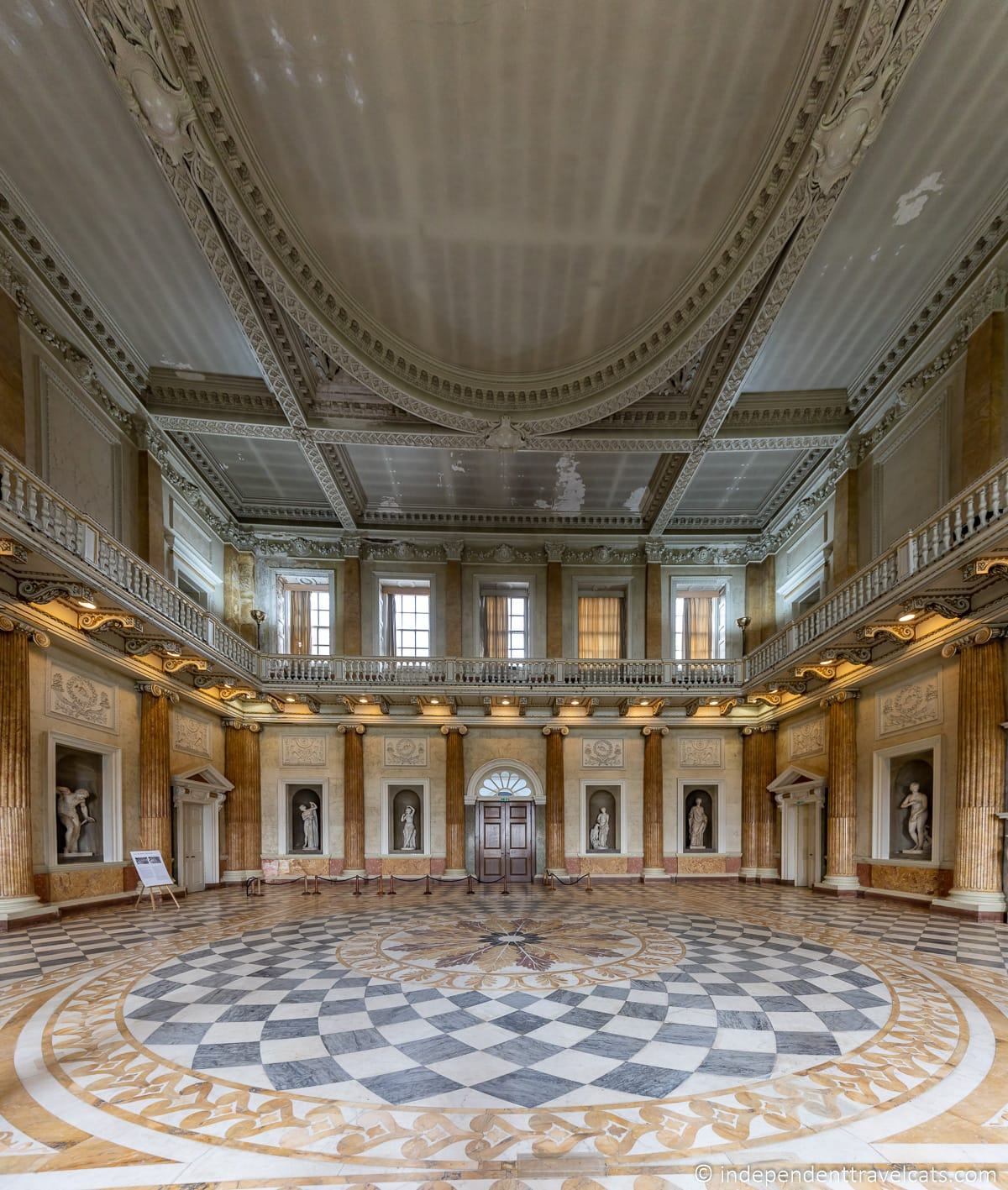
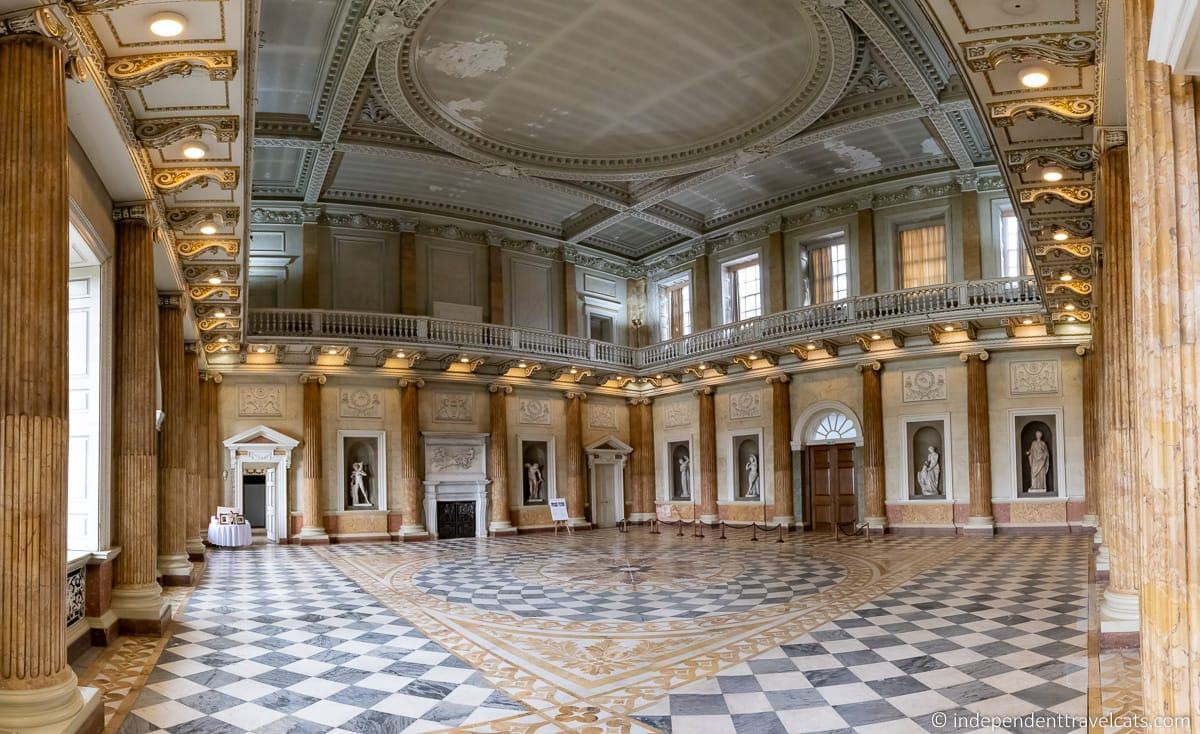
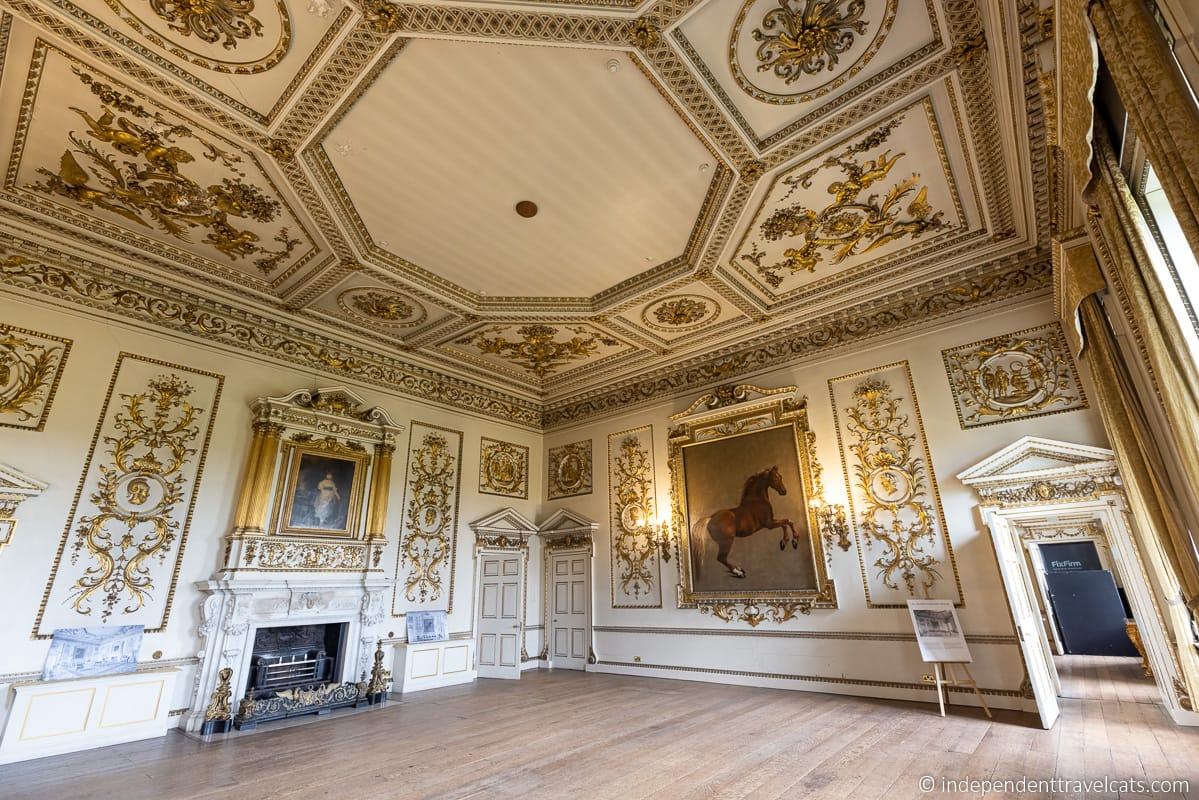
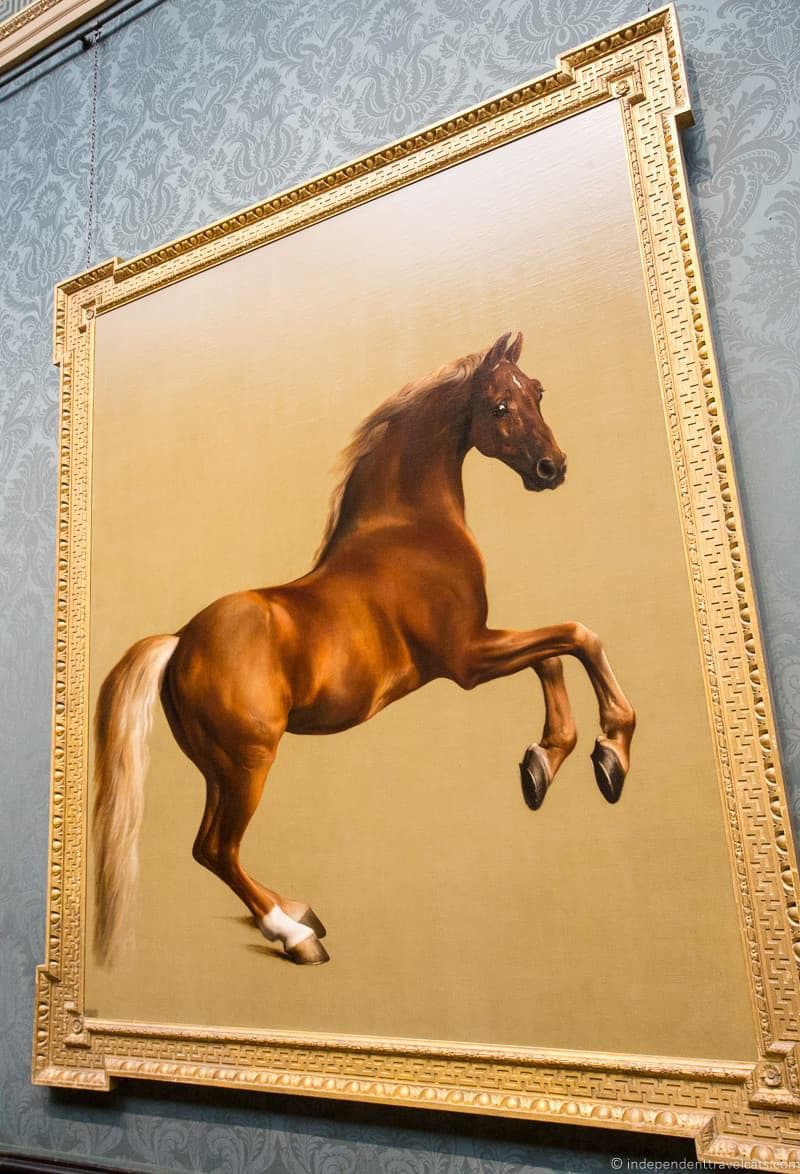
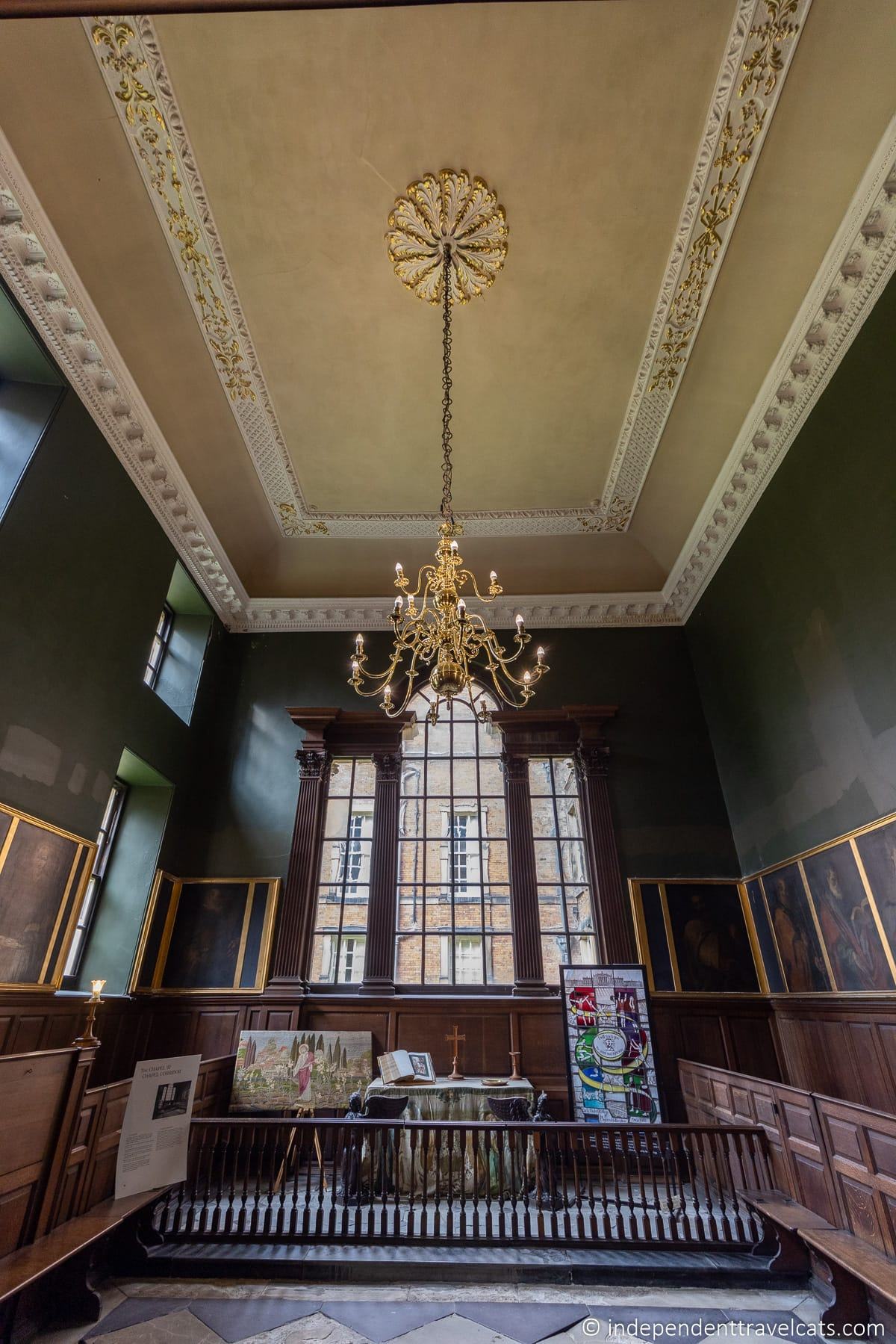
Hidden Rooms & Other Areas of the House
While most of the tours focus on the grand principal rooms of the house, some of the other guided tours such a the Hidden Tour, Black Diamonds Tour, Lady Mabel Tour, and Conservation Tours also include other areas of the house.
These tours can be a fun peek into rooms that are not currently open to the wider public and to see the current restoration and conservation efforts. It gives you a chance to see areas of the house you may have read about, but can’t be seen on the regular tours.
Whereas some parts of the west wing (particularly the main rooms where the Newbold family lived) are in good condition and partly furnished, a lot of the rest of the house is in a fairly poor state of repair and in need of restoration. Be prepared to see hallways and rooms in fairly poor condition. Like the rest of the house, very little of the original art, furniture, and décor remain.
Some parts of the rest of the house retain their original features, but many were altered considerably by later occupants, particularly the PE college. The PE college even built additional structures onto the house, such as into one of the inner courtyards. This is a bit strange given the immense size of the house!
If you are hoping to see the original kitchen, servant quarters, and the “below the stairs” areas of the house as you may have seen in other historic homes, you won’t find much evidence of those areas here. These areas were totally altered and very little of their original state can be seen today.
It is planned that some of these areas of the house will be renovated in the future to create spaces that can be used for dining, accommodation, offices, and events in the future.
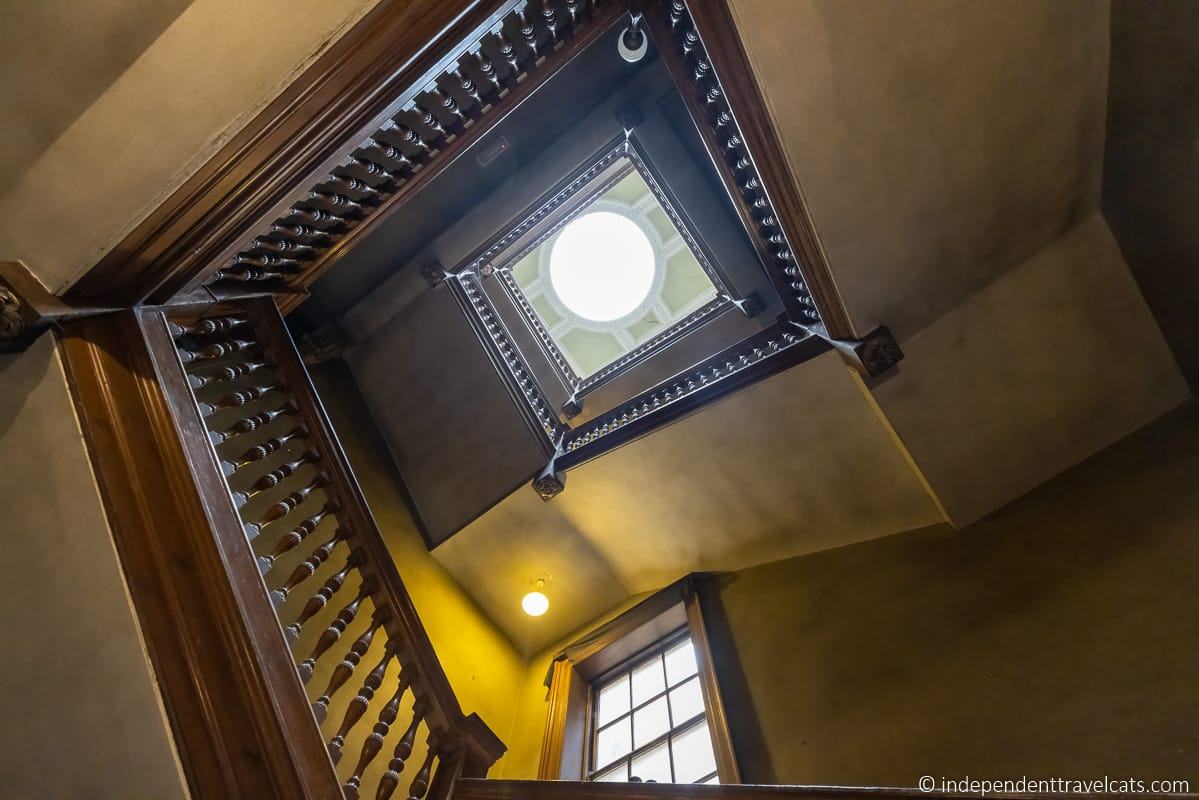
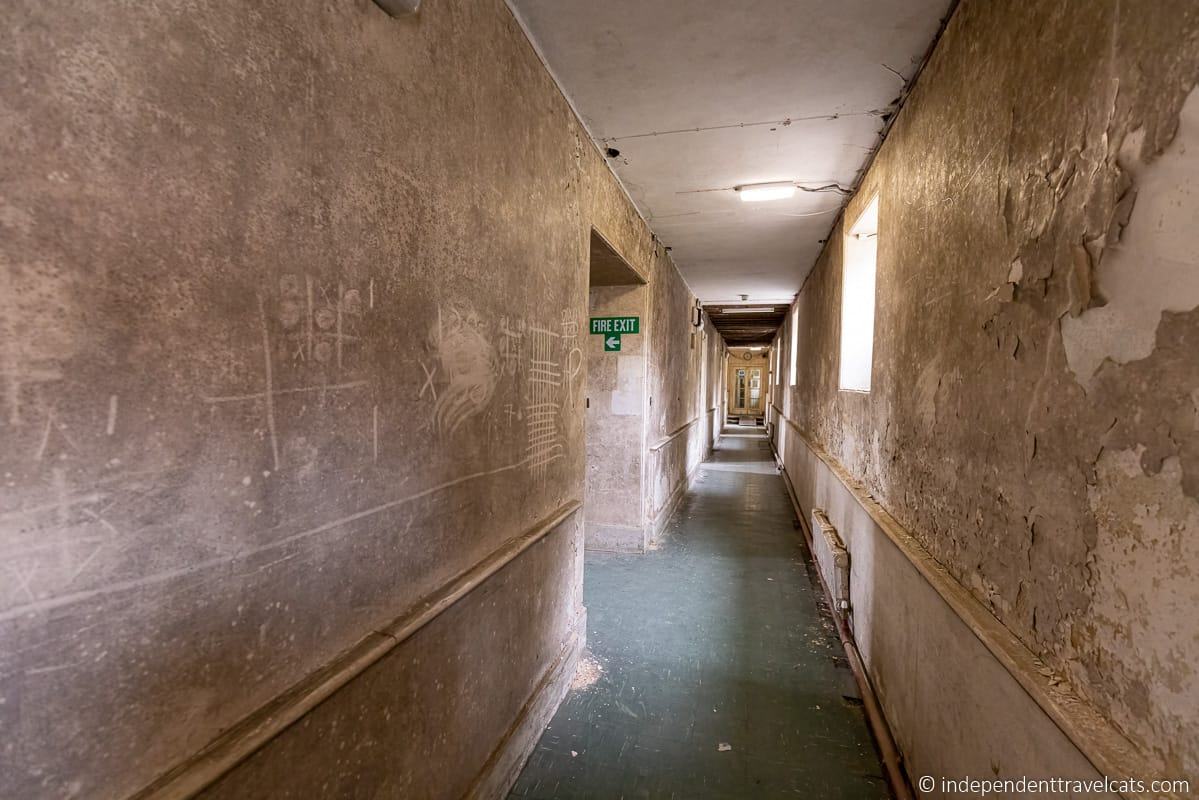
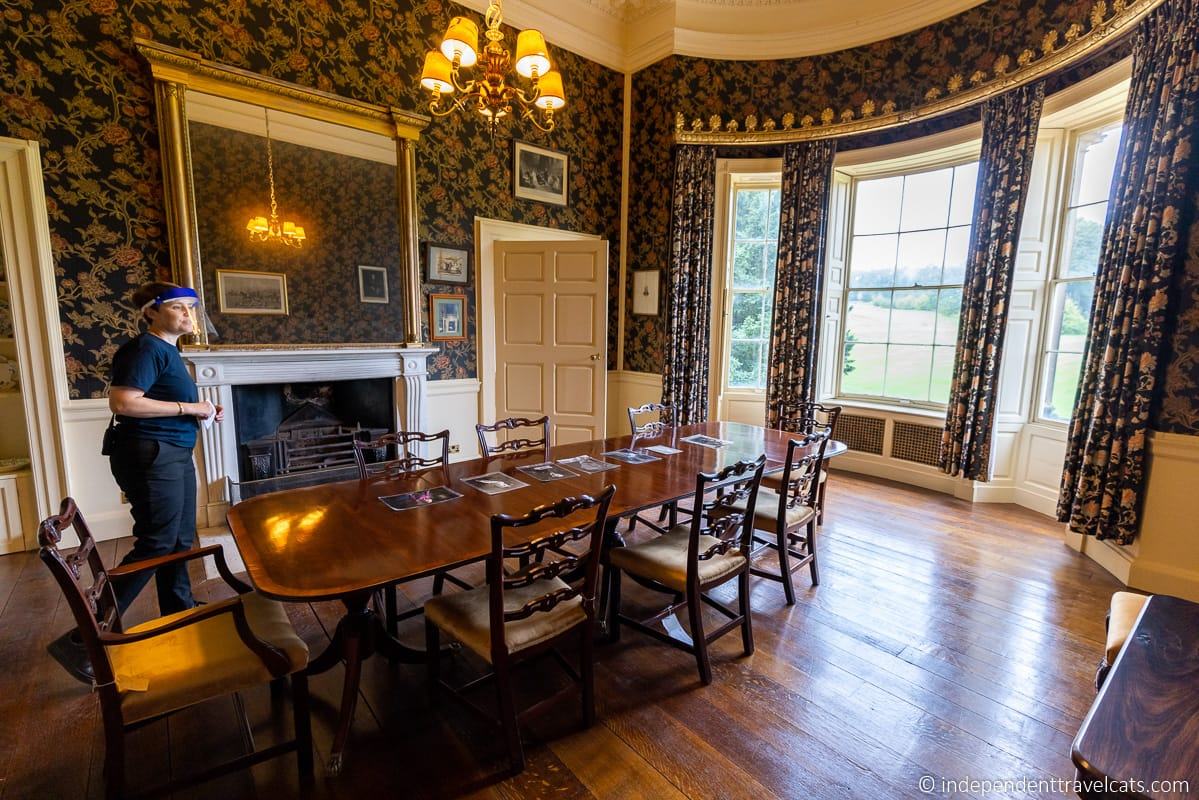
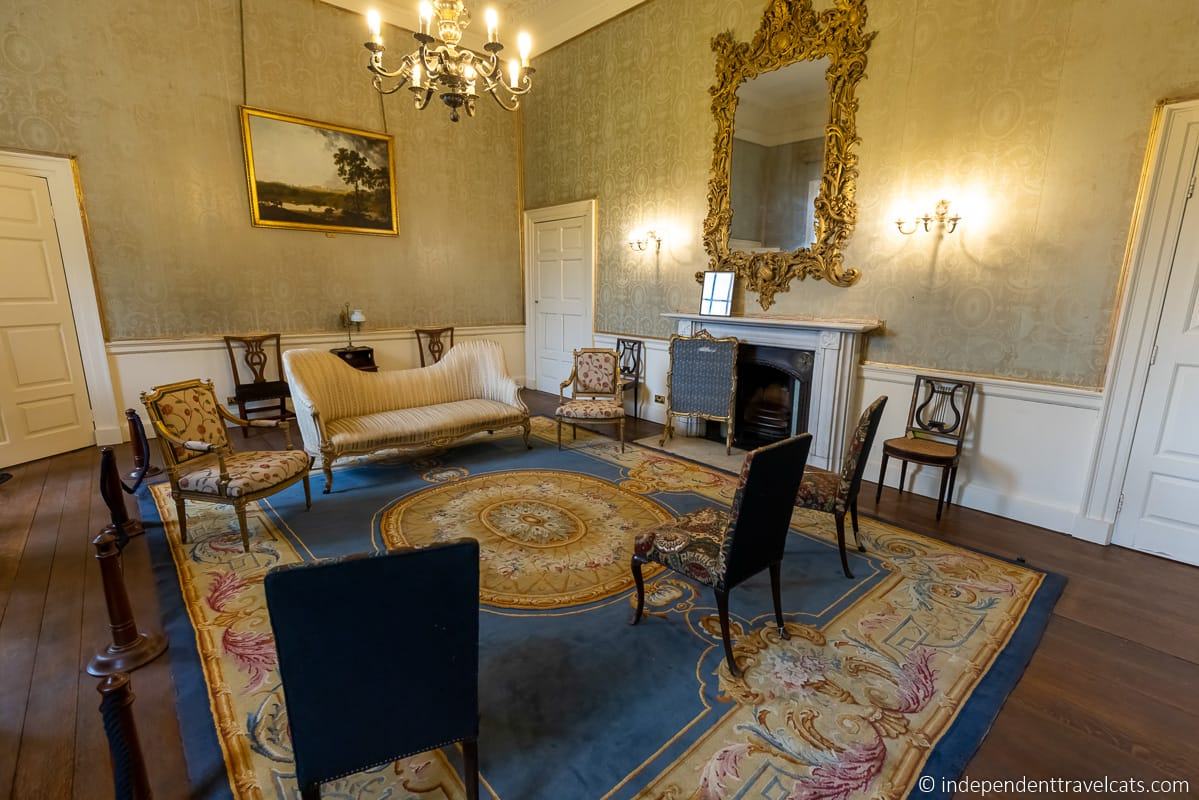
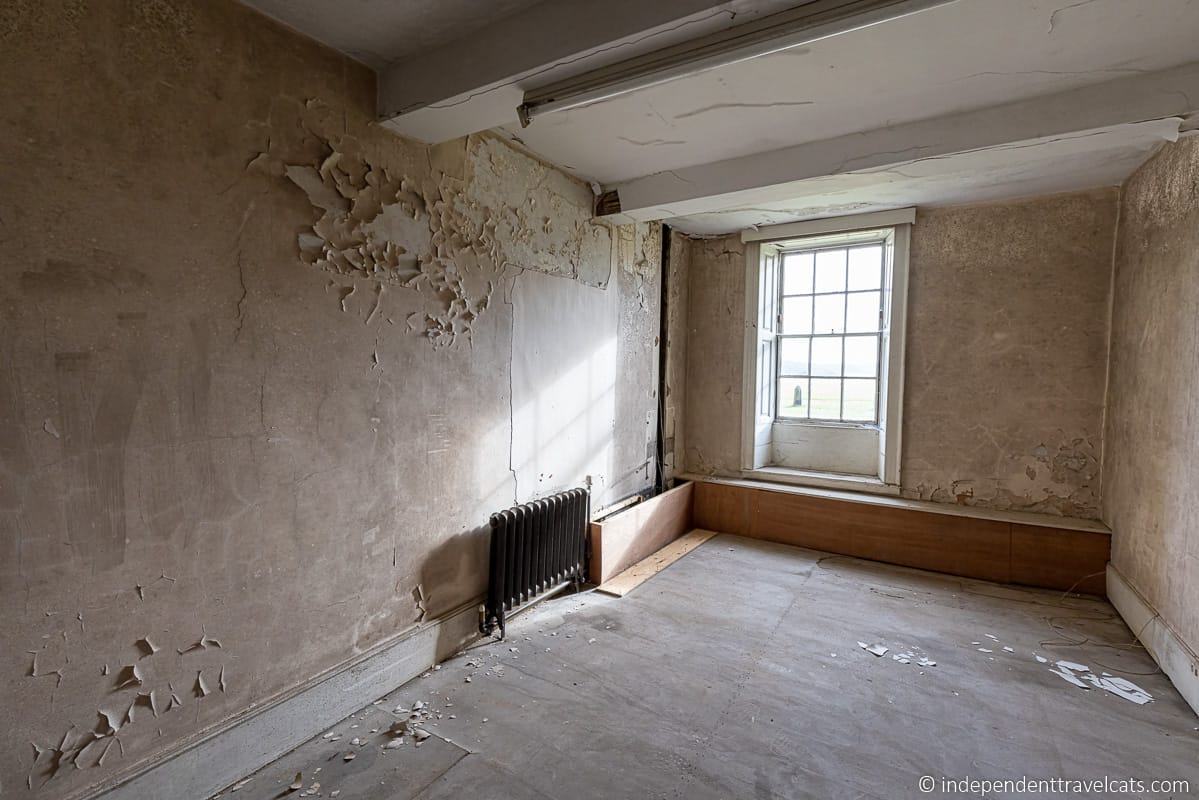
Wentworth Woodhouse Baroque Exterior & Courtyard
When you walk out of the back of the house to the garden, you’ll likely pass through the courtyard. Here you can view the oldest parts of the house, The garden portion of the tour begins with a walk outside to a courtyard where you can view the oldest parts of the house, including the remains of the original 17th century house and the English Baroque part of the house.
During our first visit, our guide Bob pointed out to me the outline of the original house and then how the Baroque addition was added. The gateway, or stone wellgate, here is believed to have been moved from its original spot and has been attributed to famous British architect Inigo Jones.
After you leave the courtyard, you go around the building and walk along the straight path that leads from the entrance of the West front of the house towards the garden. In front of the west side of the house once stood a 300-year-old beech-lined avenue and famous pink shale ornamental driveway and path that led to the front door of the house. Both of these were destroyed by the opencast mining that took place here following WW2.
The Baroque part of the house was built in the 1720s to expand and replace the existing Jacobean house. The Baroque style house was built of red brick by architect Ralph Tunnicliffe for Thomas Watson-Wentworth, 1st Marquess of Rockingham. The English Baroque style West Front was completed in 1734; however, the Wentworths had already begun building the Palladian East front of the house even before the west front was completed!
It was believed that the Baroque style was no longer fashionable and the style was disliked by the Whigs. So the family decided to build the sandstone Palladian style eastern wing that would serve as the primary façade and entrance to the house. This is why today we have essentially two back-to-back houses built in the same period, one Baroque and one Palladian. So the Baroque part of the house became the more private “garden front” and the Palladian part of the house became the public face of the house.
The Baroque part of the house, although perhaps not as grand as the Palladian East front, is a still a great sight to behold.
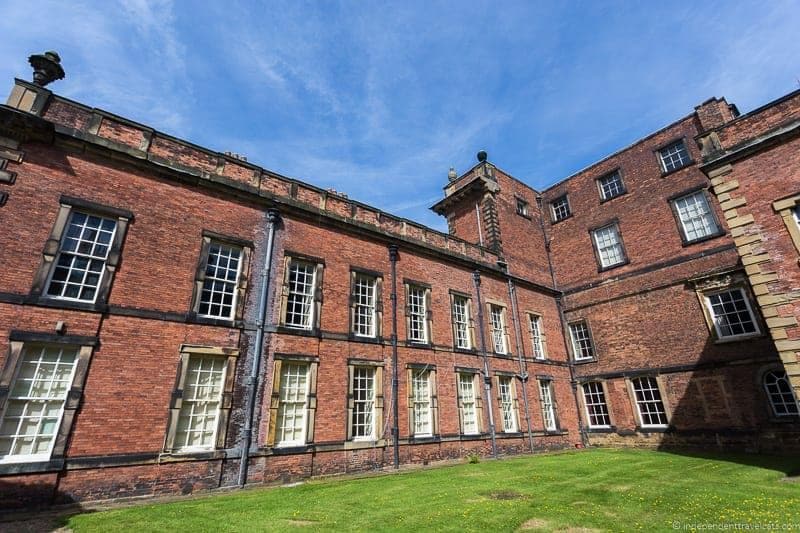
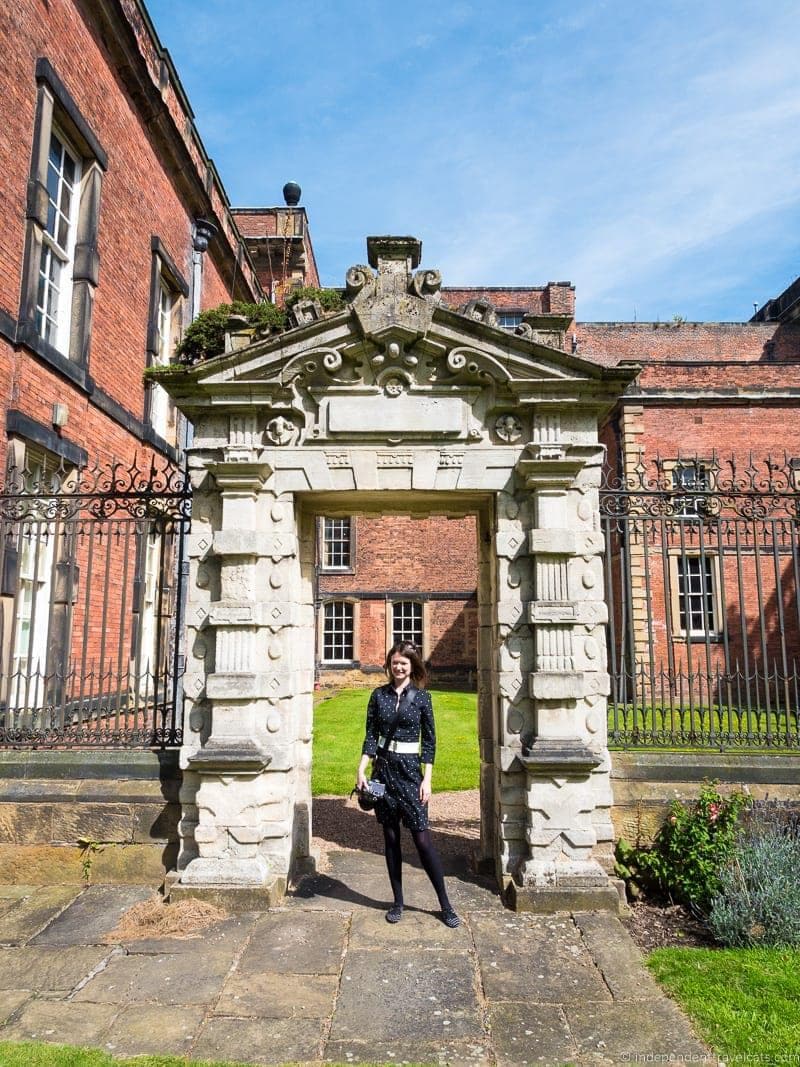
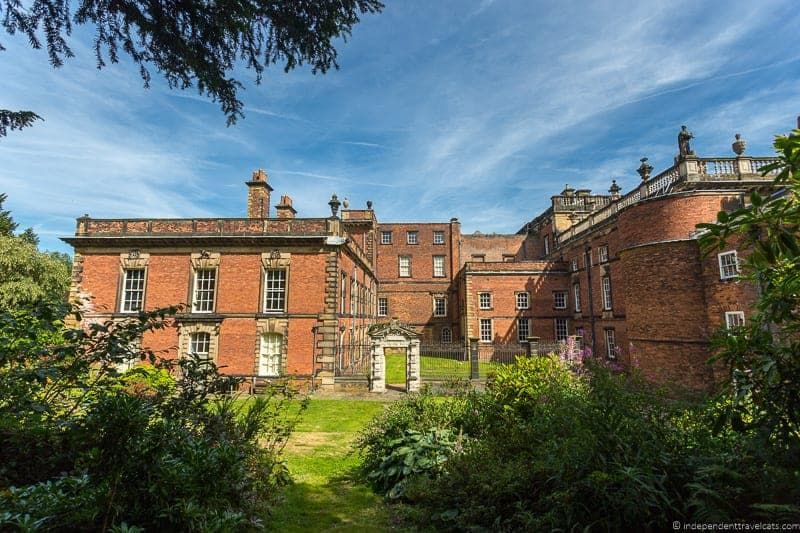
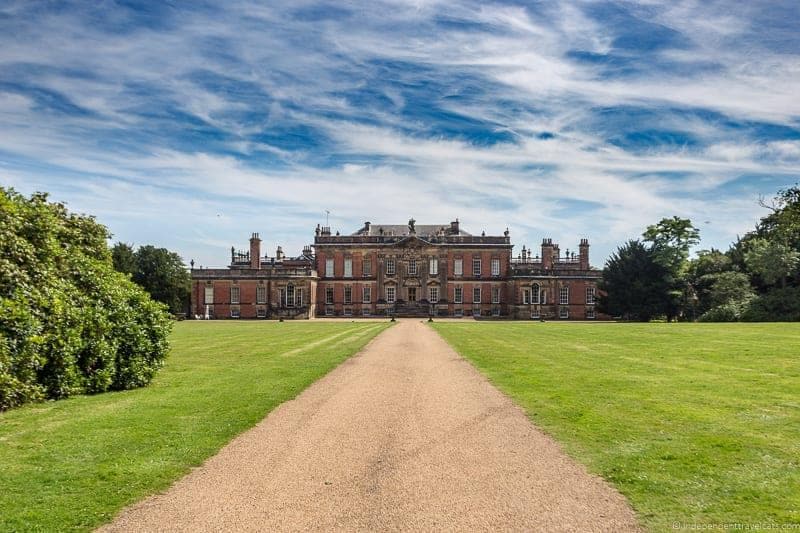
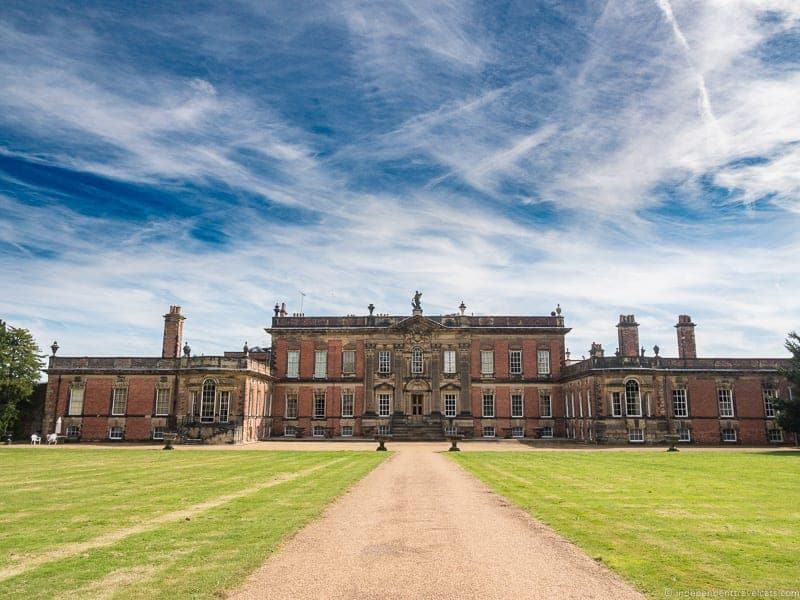
Wentworth Woodhouse is definitely a house with two faces and a multitude of tales! Which side do you prefer, the grand Palladian East front (top) or the English Baroque red brick West front (bottom)?
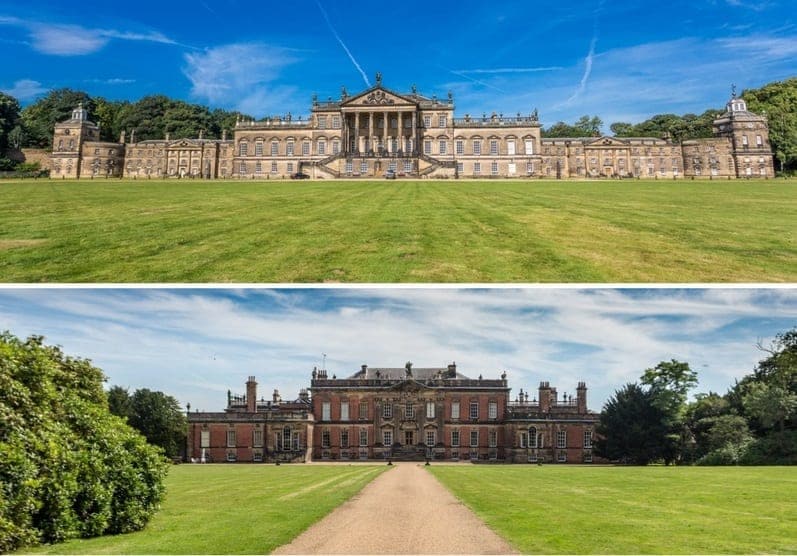
Wentworth Woodhouse Garden
You can access the Wentworth Woodhouse garden via the house. Garden access is generally included with guided tours and can also be purchased as a separate ticket if you just want to visit the garden. You can explore the gardens on your own, although there is sometimes a guided Garden Tour on offer.
Our first visit to the Wentworth gardens was as part of a guided tour, but when we returned in 2021, we visited it on our own after our tour.
The park here was originally laid out by Humphry Repton around 1790. Much of the gardens and the features have disappeared due to open-cast mining, breaking up of the land, and neglect, but there is still much to see here.
One of the highlights for us of the garden was the South Terrace which has a very long retaining wall with a raised area that was used for the family and guests to sit, relax, and take exercise. From here, you have a good view over the nearby park and farmland. You’ll also find the Punch Bowl (large decorative urn) and Ionic Temple here. The 18th century Ionic Temple folly is made of sandstone and features a statue of Hercules inside killing a beast.
You can wander around and see the various decorative elements of the garden, historic trees of note, the Camelia House (currently undergoing restoration), wildflower meadow, beehives, and the kitchen garden. The historic gardens at Wentworth Woodhouse have been found to include many trees which are classified as exceptionally old, large, and rare.
These gardens are where the opencast coal mining took place after WWII and the gardens are still recovering from the effects of that mining. There are a couple of photos in the house that show how close the bulldozers came to the house.
There is often a refreshment stand set up in the garden near the house that sells drinks, snacks, and ice cream. There are also deck chairs available in warmer weather.
Note that if you are interested in the gardens, you may want also want to pay a visit to the next door Garden Centre as it sits within the former historical kitchen garden and pleasure garden of Wentworth Woodhouse. You can still visit the walled garden there.
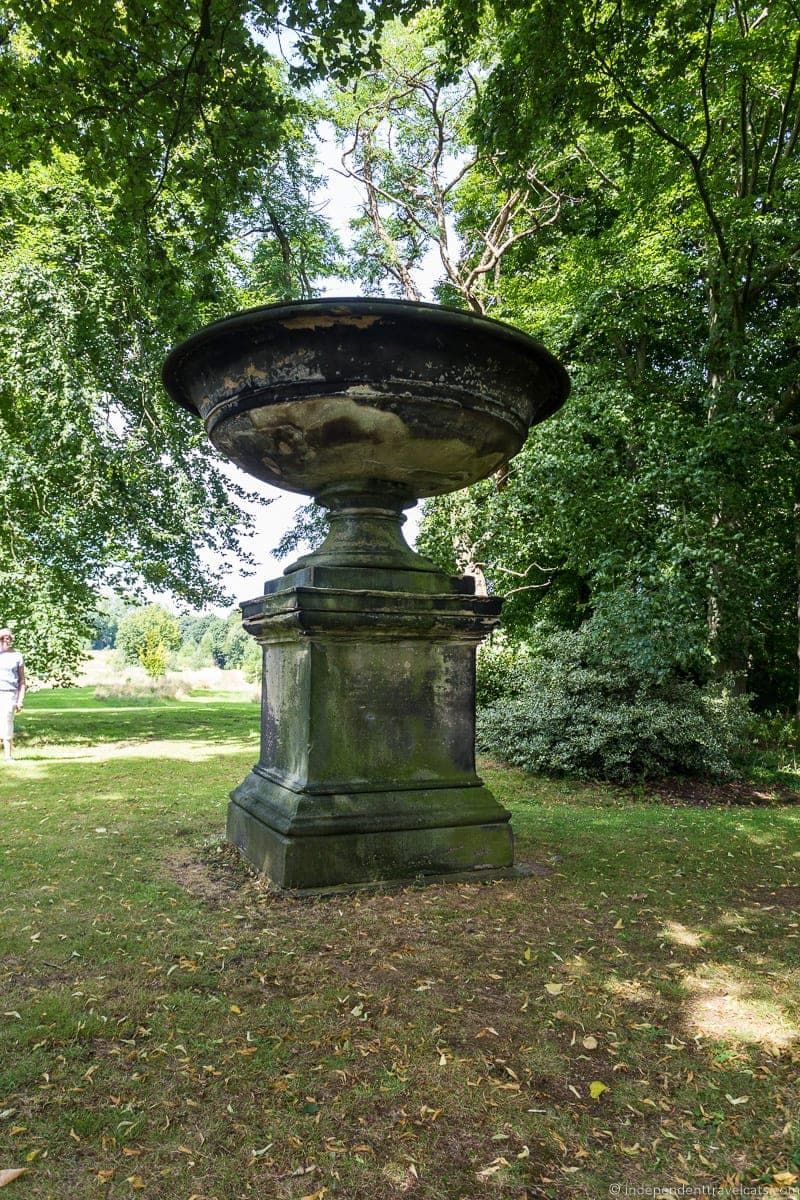
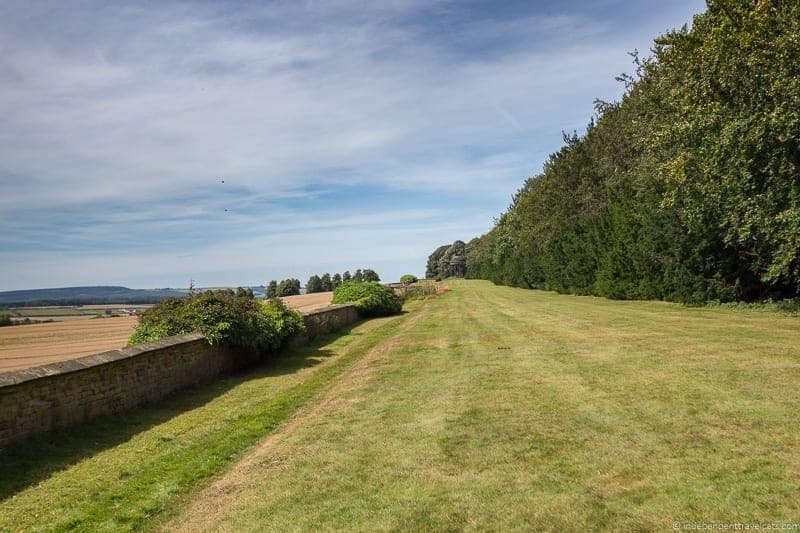
Wentworth Woodhouse Stables
As you drive or walk up the driveway to Wentworth Woodhouse, one of the first things you are likely to notice is the massive Palladian stable block. The stables building is huge and it is not surprising that some visitors have stopped here, thinking they’ve reached the house!
A motto on the gate into the stables reads: “Honi soit qui mal y pense”, a common British heraldic motto, which translates to “Shame be to him who think evil of it”.
There had been a stables building here since the 1630s, but the first was relatively small. In the 18th century, a new stables was built by the 2nd Marquess of Rockingham and designed by architect John Carr. The massive new stables complex could accommodate up to about 100 horses and was the largest private stables in the country when it was completed in 1782. It also included a riding school and accommodation for the grooms, stable boys, and house gardeners.
In later years, the stables were used as a garage, estate offices, barracks for the British Army during World War II, and as classrooms for the Lady Mabel College of Physical Education.
The Stables can be seen from the exterior (different sections are visible from both the road and from within the gardens) and the interior is sometimes open to the public. Guided tours that focus on the Stables are sometimes offered. The plan is to continue to open up these buildings and to turn them into a restaurant, retail spaces, and a large event space in the future.
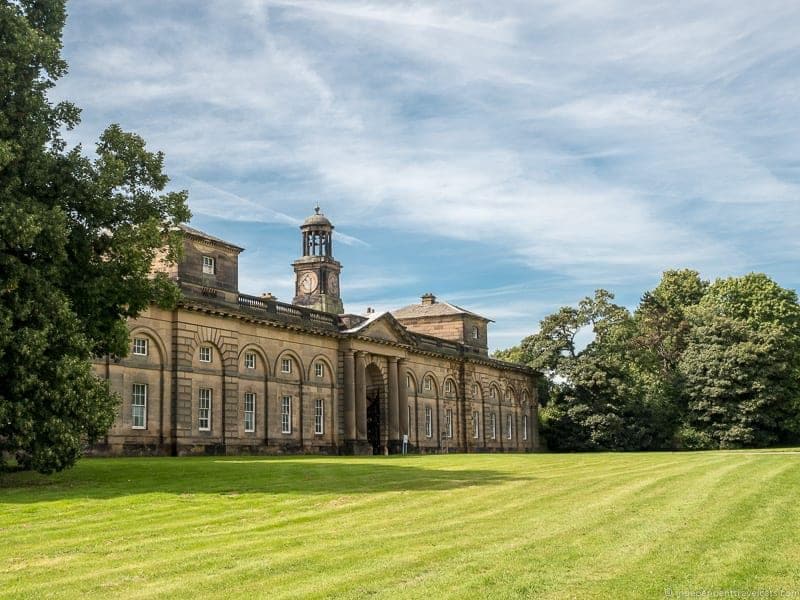
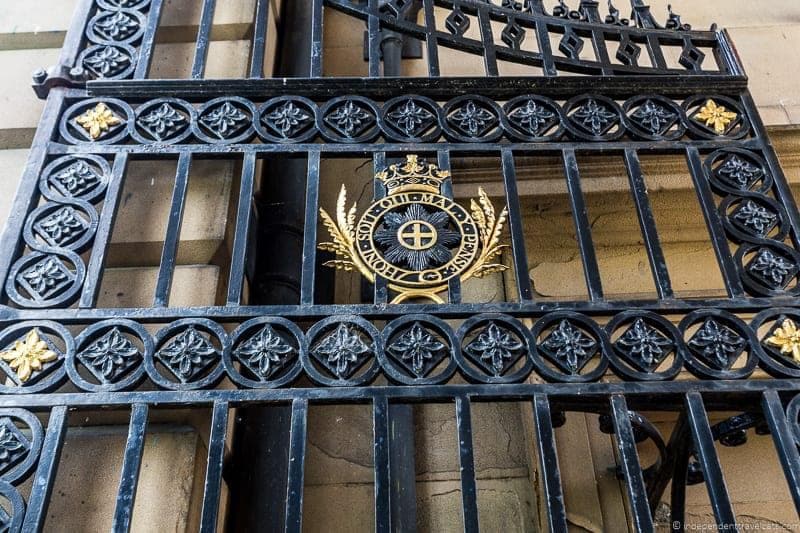
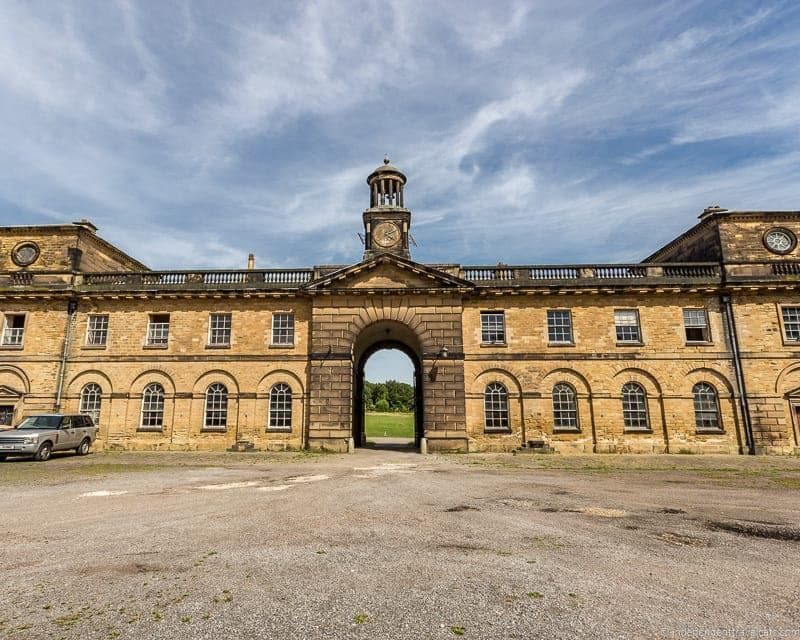
Wentworth Woodhouse Wider Estate and Parkland
As noted earlier, much of the land around Wentworth Woodhouse (with the exception of the front lawn, gardens, and mansion) is owned and managed separately by the Fitzwilliam Wentworth Amenity Trust. So you may want to leave extra time to visit other areas of the park and village.
If you want to explore the parkland, there are a number of public footpaths. There are a number of 18th and 19th century monuments scattered throughout the area, including Needle’s Eye, the Rockingham Monument, Hoober Stand, and Keppel’s Column.
You can check online for more information about visiting the Wentworth Estate.
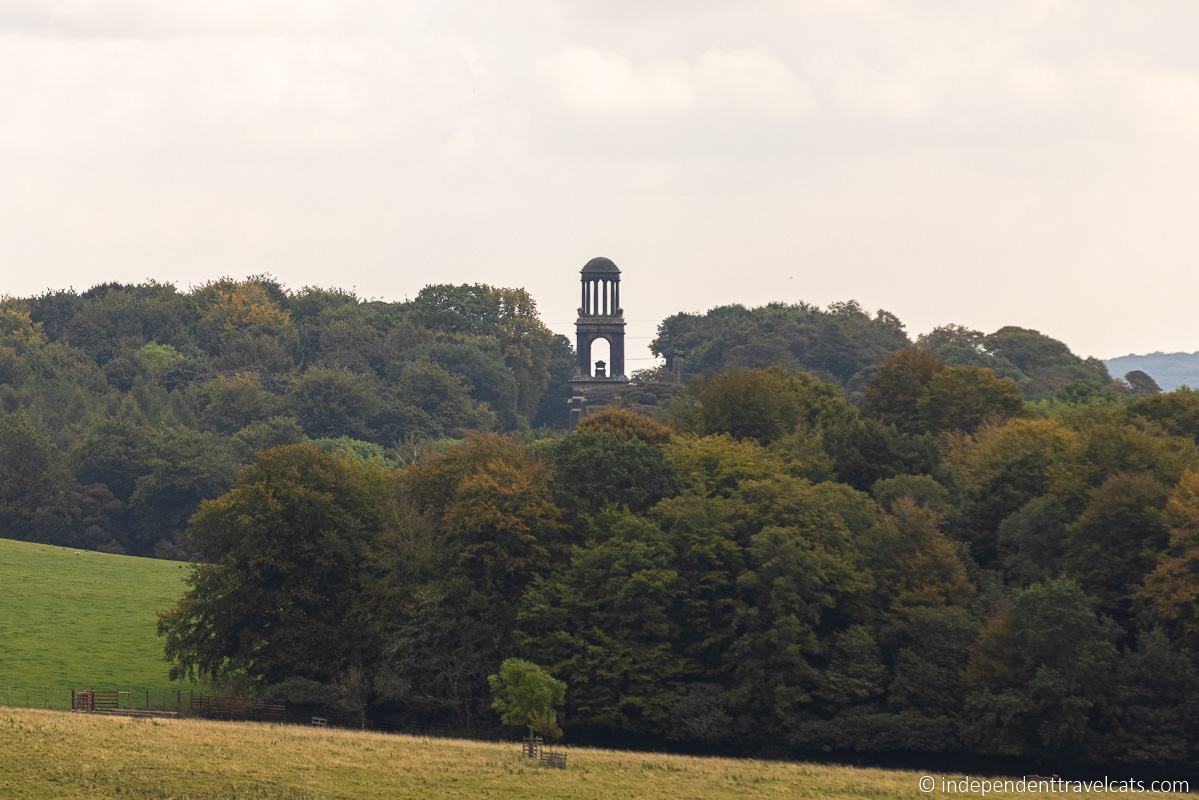
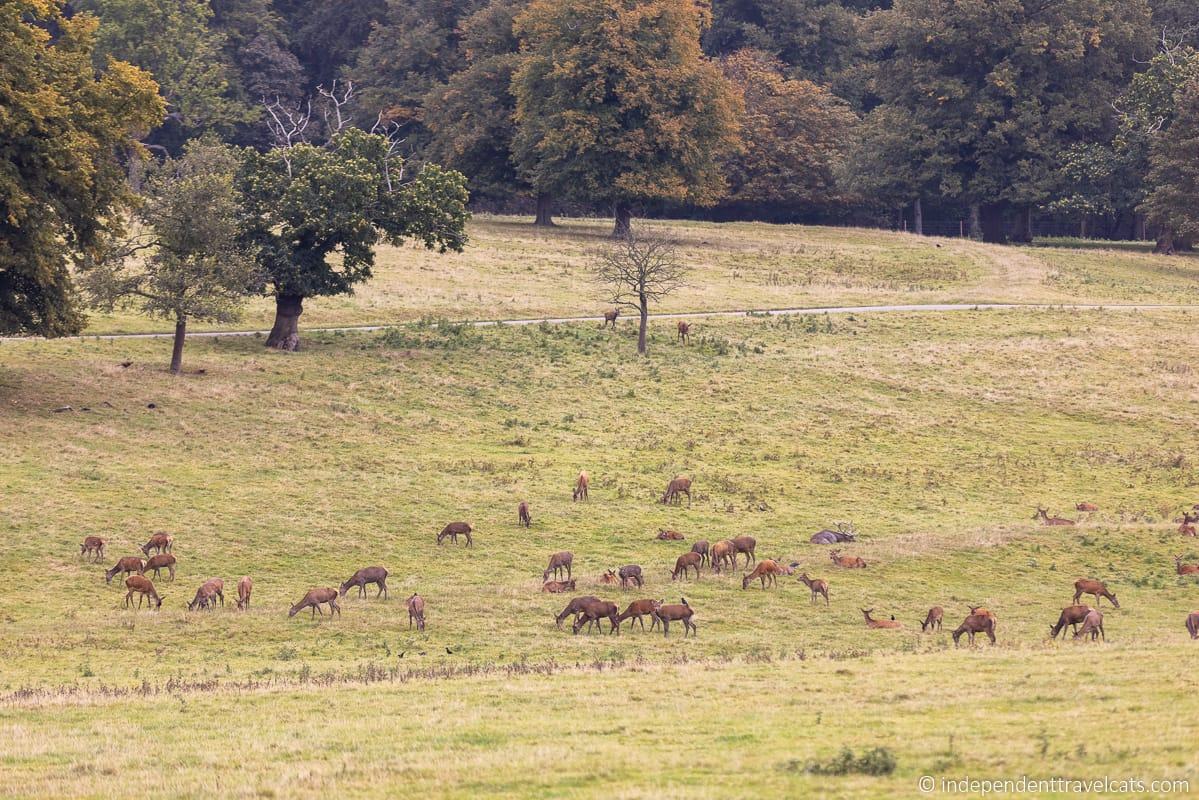
We hope you enjoyed learning about Wentworth Woodhouse and reading about our tour of this great English house! We greatly enjoyed our tours of Wentworth Woodhouse and this is a place we hope to visit again to see the progress as more restoration is done on the house.
Wentworth Woodhouse, once home to one of the wealthiest aristocratic families in England, has been on the brink of decay and destruction in recent decades. Although there is much work to be done, the house has survived and the public has continued to show interest in preserving this architectural treasure. As one of England’s great houses, I hope it is restored and that some of the original art and furnishings can once again festoon this magnificent house.
Although the house is still not well known to the general public, I have a feeling that will change in the very near future!
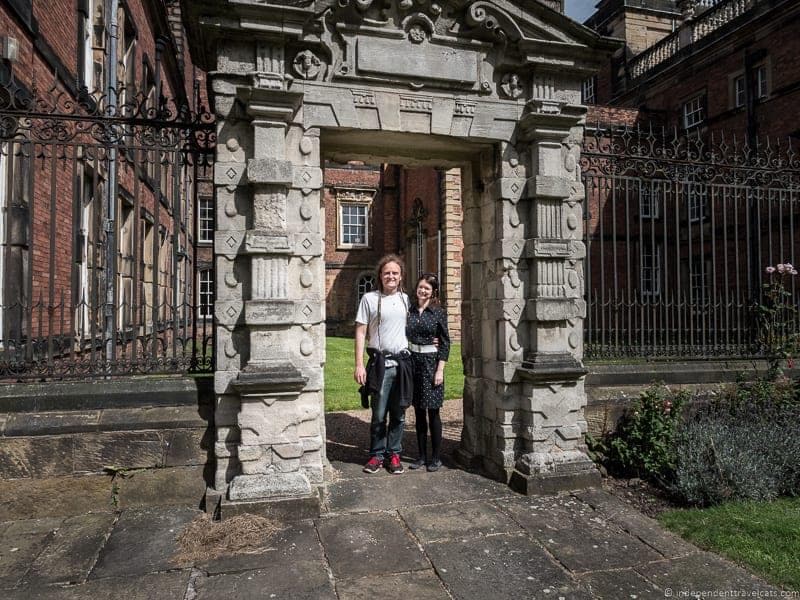
We hope you enjoyed learning about Wentworth Woodhouse and coming along on our tour of this great English house!
Have you ever heard of Wentworth Woodhouse before? Would this be a place on your Yorkshire trip itinerary? If you’ve visited yourself, we’d love to hear about your experience, and as always, we’re happy to answer any questions you may have about visiting Wentworth Woodhouse. Just leave us your comments or questions in the comments below!
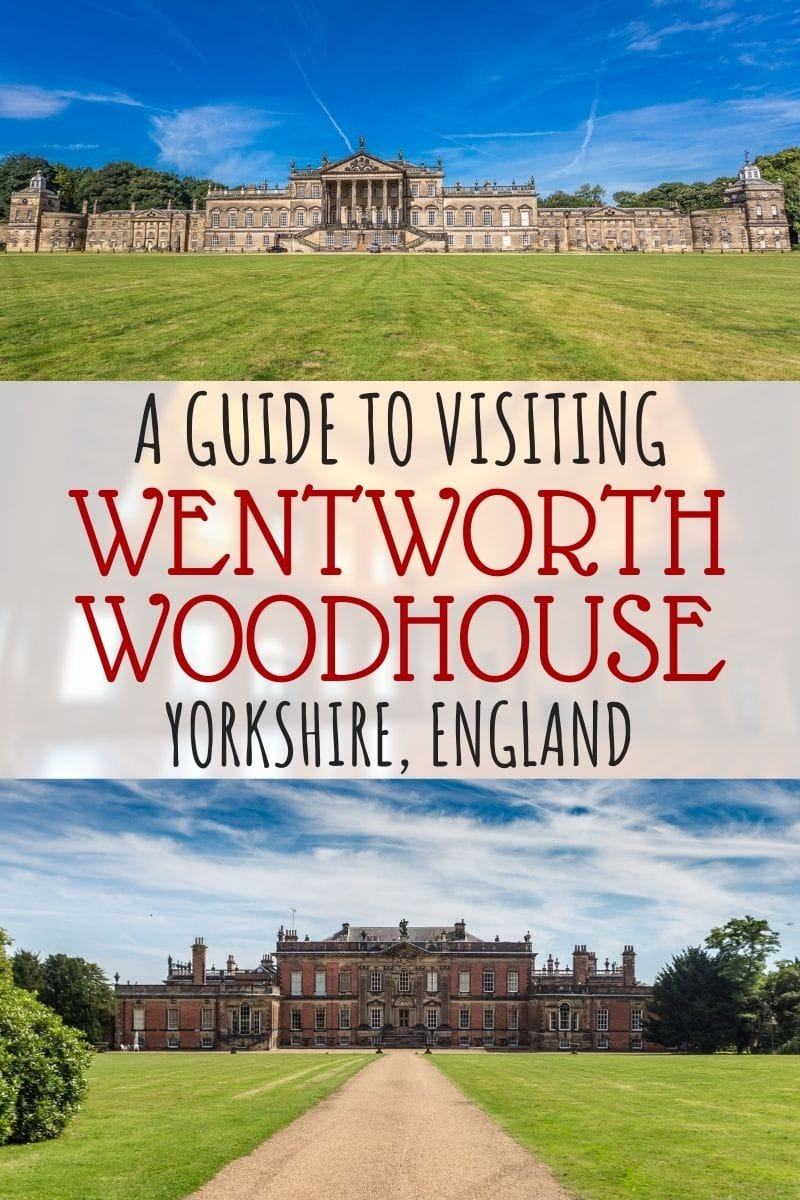
**Disclosure: We were provided complimentary tour tickets to Wentworth Woodhouse in 2016 order to review the tour as travel writers; however, all other expenses during our trip were covered by ourselves. We fully funded our 2021 visit and tour of the house. As always, this article contains only our own honest thoughts and opinions. You can read more in our Ethics Code about how we accept work.**

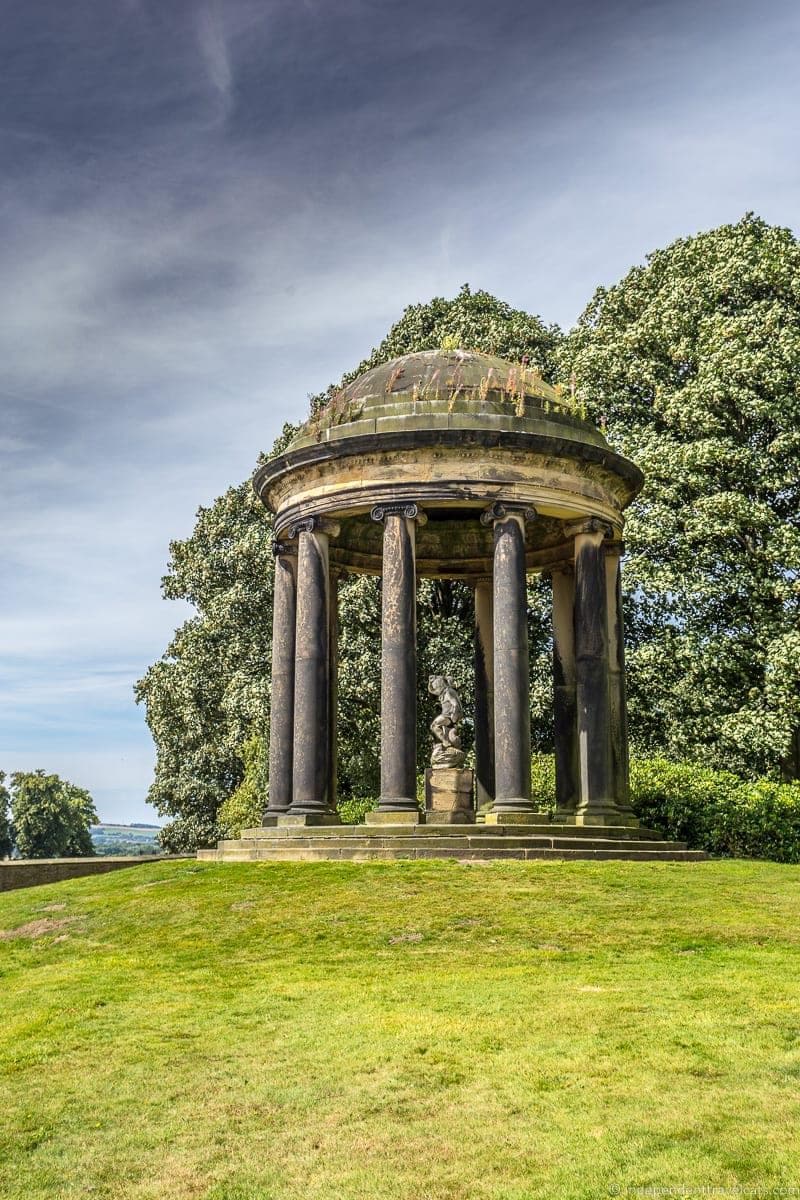
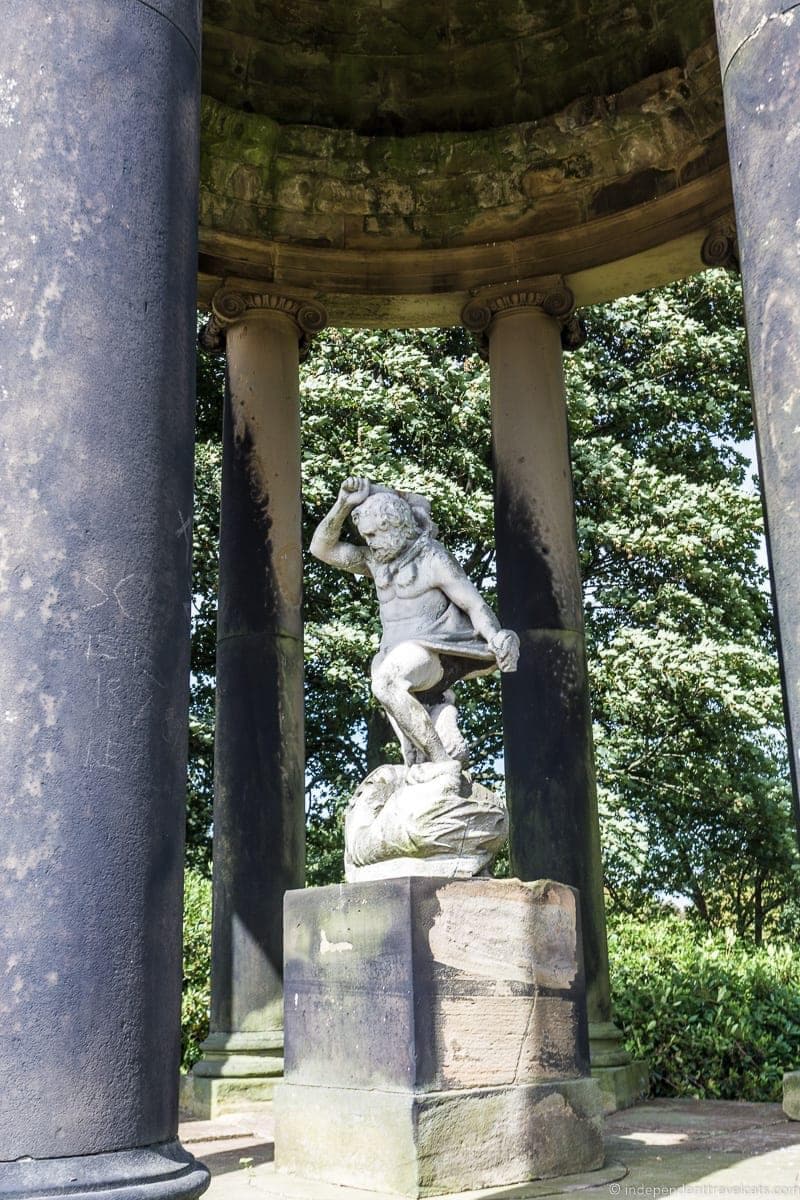
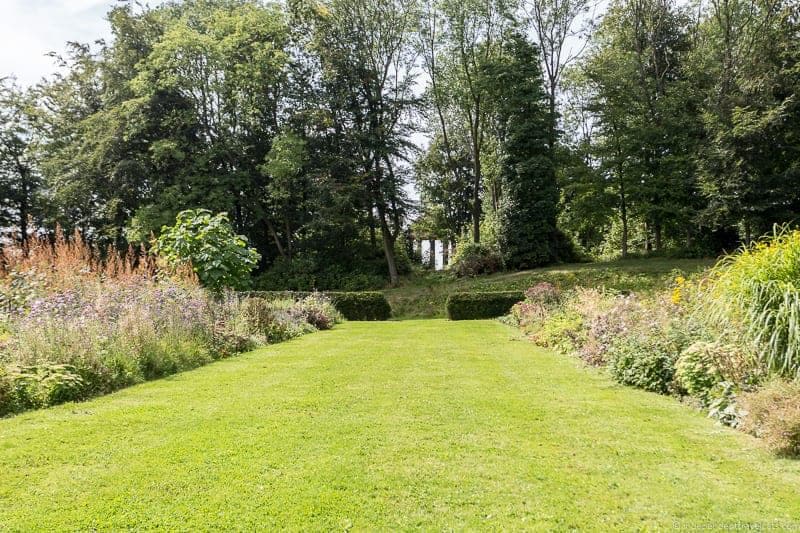
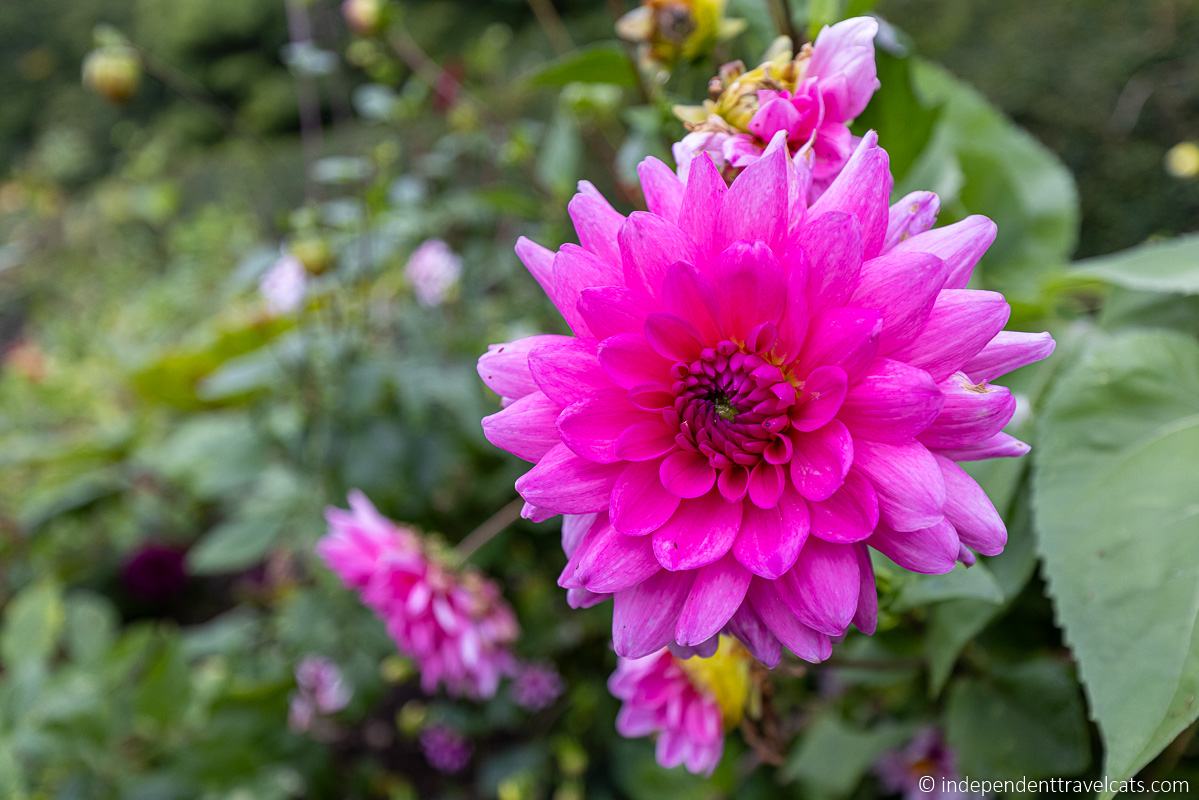
Chris L Post author
Great review of Wentworth Woodhouse! Nice to catch up on the old place. I lived in nearby Thorpe Hesley when I was 8 years old and between 1976 and 1986 used to regularly “haunt” the estate on Sunday afternoon walks, looking through the windows, exploring the gardens (I loved the bear baiting pit!). The house wasn’t open in those days – but we could roam the grounds freely. Also, many a Boxing Day morning spent seeing the fox hunt leaving the Rockingham Arms. As a moody teenager (in a rock band) we even posed for photographs in the gardens – never made it to number 1 though :-). I didn’t realise the place was so beautiful inside and I’m so glad it’s getting the respect it deserves. I am definitely going back to visit ASAP! PS I’ve just ordered Black Diamonds … can’t wait. Thanks for your blog.
Jessica & Laurence Norah Post author
Hi Chris,
So glad you enjoyed our article and photos of Wentworth Woodhouse. Nice to hear about your memories there as a child. So many people who grew up nearby have shared memories of walking around that giant park. I hope you get a chance to do a tour of the house soon, the ball room is definitely a really impressive room to see. The private gardens are also really nice, especially in the Spring/Summer.
And hope you enjoy reading Black Diamonds, a fascinating read, especially since you know the village and local area!
Best,
Jessica
Kenton Post author
Wentworth Woodhouse became my favorite country house after I read the 1983 biography of President Kennedy’s sister Kathleen. She became a sensation with the British public and Aristocracy when she and her brothers & sisters came to live in the UK when their was named the new Ambassador to the Court of St Janes. She married the eldest son of the Duke of Devonshire but he was killed just 4 months later in WWII. After the war she began a love affair with Peter, the 8th Earl Fitzwilliam who was married at the time but was trying to divorce his wife when both he & Kathleen were killed in the South of France when their plane crashed during bad weather.
Jessica & Laurence Norah Post author
Hi Kenton!
Yes, you are correct and as noted it was really the 8th Earl Fitzwilliam’s death that likely hastened the demise of the house (or at least partly) since he left no heirs. The house then passed to a cousin who was older and who also had no heirs.
Kathleen had a stronger connection to Chatsworth House (her husband’s family home) and that is another great country house to visit in England. She is buried at St Peter’s Church in Edensor, near Chatworth where most of the Dukes of Devonshire are buried. You can visit her grave in the churchyard there.
Best,
Jessica
Jillian Bramley-Knox Post author
I have just been watching an episode of Antiques Roadshow which was held in the grounds of Wentworth House. It probably was an old series or even a re- run as I am in Australia. Before the program started Fiona did a small tour of the building. I have never heard of it and so enjoyed your blog. I found your blog very informative and great photos, it’s a pity we can’t do a virtual tour of the house. It was interesting to hear of the Kennedy connection, I had read about that part of history but never knew where they lived.
Jessica & Laurence Norah Post author
Hi Jillian,
So glad you got to see that show and found our blog about Wentworth Woodhouse. Yes, I know they had the Antiques Roadshow at Wentworth Woodhouse in 2014 and aired an episode then. I am not sure if they have returned since then or not since the house has been more open to the public. They definitely have a lot more things happening these days at the house, such as car shows, craft events, holiday parties, etc.
Likes most things here in the UK, Wentworth Woodhouse is temporarily closed due to the COVID-19 outbreak. I don’t think there is a way to view it virtually, unfortunately, but I would recommend reading Black Diamonds to learn more about the house and the people who lived there if you have the chance.
I hope you have the opportunity to visit it in person someday 😉
Best,
Jessica
Sharon "Matheny" Whitley Post author
I’m so glad that I came across your blog about the Wentworth Woodhouse. It’s always been my dream to visit that area. My family tree has been linked to the Wentworth’s via their U.S. branch of the family. Thomas Wentworth came to the U.S. sometime in the 1600’s. His daughter Sarah married Daniel Matheny and thus our line to the Wentworth family was established. (And it looks like their descendants are many). For so many years, I’ve wondered about the Wentworth Woodhouse story and recently decided to surf the web to see what information that I could find and to see if the home was still in place. I found the official website but was more excited when I found your blog and could get your perspective as a visitor and your historical perspective. My husband and I are hoping to get over to the UK next year so I may persuade him to make a side trip to visit this site. Thank you!!!!!
Jessica & Laurence Norah Post author
Hi Sharon,
That’s really interesting, I don’t know much about the American line of the family. Lady Juliet Tadgell (and her children) is the direct descendant of those that owned the house and she is the last person still living that once lived there. She still lives in the UK but hasn’t lived in the house since she was a child.
If you haven’t read Black Diamonds, I highly recommend reading it as I think you’ll find it interesting about the family and history of the house. It was the book that got me really interested in visiting the house.
I hope that if you visit the UK next year that you have a chance to visit Wentworth Woodhouse. It is a bit out of the way, depending on where you might be interested in going, but definitely worth a visit if you are in northern England.
Best,
Jessica
Catherine Wentworth Post author
Thank you for your detailed post about Wentworth Woodhouse. I’ve long wanted to visit the house and castle but something else always got in the way. Plus, I’m usually in the UK in December which isn’t the greatest month to head in that direction. Anyway, it looks like it’s going to finally happen this year, hence Googling and finding your informative post. Nice job. I’ll be sure to read it again shortly before my trip.
Jessica & Laurence Norah Post author
Hi Catherine, I hope you do get a chance to visit Wentworth House and Wentworth Castle this year! Now, the castle is I think currently closed to the public, but it is hoped that the Wentworth Castle gardens will reopen this summer. So do check the website and schedule closer to the time as restoration efforts are ongoing at both sites. Best, Jessica
stephen cox Post author
Having discovered whilst researching my family tree that I’m related to the Wentworth family through marriage (my cousin Sarah Cox married William Charles Wentworth – part of the Australian branch of the Wentworth family – and very famous in his own right as an explorer, politician in the early colony – research Vaucluse House for further info) – I have since researched a lot into Wentworth Woodhouse and the family.
Hoping to visit this summer which will be a little weird knowing the family connection – your review has done a great job of showing off all it has to offer. Thank you. ????
Jessica & Laurence Norah Post author
Hi Stephen, So interesting, sounds like you have uncovered quite a bit of information in your genealogy research!
Yes, it does seem that the Wentworth family has a lot of connections and branches (for instance Wentworth Woodhouse and nearby Wentworth Castle were later owned by separate branches of the family). Speaking of which if Wentworth Castle & Gardens (the National Trust took it over in 2018) is re-opened to the public by your visit, I’d make a stop there as well.
Wishing you a great summer trip!
Jessica
stephen cox Post author
Thanks Jessica, I know William Charles visited Wentworth Woodhouse when he visited England with Sarah and went to see his cousin Earl Fitzwilliam who had supported William’s father D’Arcy Wentworth when he was in Australia as part of the colony foundation. One of D’Arcy’s homes in Australia was also called Wentworth Woodhouse in honour of the Yorkshire one.
I don’t know if you are aware but It’s been suggested by a distant cousin of mine in books he has written that D’Arcy was well known to Jane Austen (perhaps even secretly married to her) as she is also distantly related to the Wentworth family and that the character Mr D’Arcy is in recognition of the fact. Many of Jane Austen’s places and characters have their basis in the family; Wentworth, D’Arcy, Fitzwilliam Woodhouse etcetera so it’s a possibility….
Anyway thanks for the best wishes. Stephen
Jessica & Laurence Norah Post author
Hi Stephen, Thanks for that info about the links to Australia. I have heard of the connection to Jane Austen to the Wentworth family however, the Jane Austen Society and most people do not believe there were any direct links to Wentworth Woodhouse and no evidence that Austen would have ever visited. Best, Jessica
stephen cox Post author
Indeed Jessica. I’m not here to persuade anyone of any link of course, but the 2 volume work does make interesting reading and considering most people in her life time did not know who Jane Austen even was beyond “the Author of Pride and Prejudice” as she was described when Emma was published- no one would really know beyond her own family how she lived – not even dare I say it the Jane Austen Society! – and a clandestine marriage wouldn’t have gone down well with her father Reverend Austen. As a matter of record Jane was the first great grand niece of D’Arcy Wentworths second cousin 3 times removed ha ha – I think I may even be more closely related to him than that as he was my cousins father in law! Anyway enough of that I’m not here to cause controversy. If walls could talk Wentworth Woodhouse could tell a whole library of tales! I can’t wait to visit! Best wishes Stephen
Jessica & Laurence Norah Post author
Hi Stephen, Yes, it is indeed interesting. I am not saying there are no evidence of links between that branch of the Wentworth family and Jane Austen, but just with Wentworth Woodhouse itself as there is no evidence (that I am aware of) that she visited the house or the area. Enjoy your visit. Best, Jessica
Clare Lees Post author
I first heard of Wentworth Woodhouse in the 1970s. We stayed with Lady Barbara Ricardo (daughter of Lady Elfrida Wharncliffe) in Wortley. However it wasn’t till a couple of years ago that i saw it from the outside, having read Black Diamonds a couple of years earlier, & managed a tour (mostly the Baroque wing) in Sept 2018. Talk about jaw dropping – photos really cannot do it justice. Thete is a lot needing to be done, but it’s good to see action being taken & the public welcomed into the house. Do visit if you can. I’m just sorry it took me 40 years!
Jessica & Laurence Norah Post author
Hi Clare, It is great that you stayed with relatives of the Fitzwilliam Wentworth family in Wortley in the 1970’s, and then got to do a tour of Wentworth Woodhouse a few months ago! We haven’t been back to the house for a couple of years now and we’re excited to return again as they start fixing up the interiors and doing more restoration work. Definitely hope more people find out about the house and decide to do a tour here – it is a fantastic property with so much history. Best, Jessica
Chris Hale Post author
Thanks for the excellent article! I discovered your blog/website when I googled Wentworth Woodhouse having read a recent article in the Guardian.
Jessica & Laurence Norah Post author
Hi Chris, Yes, Wentworth Woodhouse has been in the news several times over the past couple of years as it has received funding and is continuing to raise funding for a big restoration program. Fingers crossed that things continue in this positive vein as Wentworth Woodhouse has so much potential as a tourism destination and to have a positive impact on the local economy. Love the history connected to the house and families who lived here which compelled us to write this visitors’ guide at a time when few people had every heard of this massive house! Best, Jessica
mbennett Post author
Thanks for posting these. Just finished reading “Black Diamonds” which ended up sounding like the wreckers ball would be the next chapter.
Jessica & Laurence Norah Post author
Hello, Thanks for taking the time to comment. Yes, Black Diamonds was written before the house was opened up to the public, any restoration work had taken place, or it received some compensation. So good things have actually happened since. However, the house still needs a lot of work but hopefully it can be kept open and become fully functional once again in a new form. Best, Jessica
Rah-Rah Post author
Contrary to your comments photography has been allowed in the house since the Wentworth Woodhouse Preservation Trust bought it in 2017. I am a trainee tour guide there, so I know that this is correct. Also the estimated cost of restoring the house to it’s former glory is now 200 million pounds !!!!!
Jessica & Laurence Norah Post author
Hi Rachael, As of January 2017 when this article was written, photography was not allowed indoors (this was the policy since 2012). Thanks for that information, I just checked with Wentworth Woodhouse and they have recently updated their policy to now allow photos which is great. We have updated our post accordingly.
Unfortunately I doubt the house will ever return to its former glory as I imagine that is no longer possible but hopefully the Trust can give Wentworth Woodhouse a new life! Hope you enjoy your time as a trainee there, it is a wonderful property. Best, Jessica
Tony Post author
Wow, looks like a fairytale house. What are the nearest larger cities to Wentworth Woodhouse? Dream of being there someday. 🙂
Jessica & Laurence Norah Post author
Hi Tony, Wentworth Woodhouse is in the village of Wentworth, but you’ll find more services in Rotherham (~ 10 min.) and even more in the larger city of Sheffield (~ 35 minute drive). For a even larger city, the nearest in Manchester (~ 1.5 hour drive) which has an airport. Hope you get a chance to visit someday! Best, Jessica
Rob & Ann Post author
You’re right – we had never heard of Wentworth Woodhouse…but we sure want to go see it now! That facade is just beautiful, and we do have a fascination with how “1%” of old lived. 😉 Looking forward to seeing this architectural beauty!
Jessica & Laurence Norah Post author
Hi Rob & Ann, Glad that our post got your interested in visiting Wentworth Woodhouse! Best, Jessica
Bryna Post author
Wentworth Woodhouse looks amazing! I can see why guests would have trouble finding their way back to their rooms. It’s quite funny to think of them leaving a trail of crumbs so they can find their way back!
Jessica & Laurence Norah Post author
Hi Bryna, Yes, I think some guests had to walk about 1/8 of a mile to get from the dining room to their bedroom along a series of corridors so you can imagine how easy it would be to get lost or forget which room was your own! I feel sorry for the house staff that had to go around cleaning up confetti dropped all over the ground! Best, Jessica
Ruth Post author
This place may be private and considered a house but it surely looks like a palace to me. It is so grand and majestic! Love the elegant facade. I really enjoy reading about the places you visit. History nerds like me dream of stopping by these areas one day.
Jessica & Laurence Norah Post author
Hi Ruth, Yes, it is amazing that anyone would ever have a private house this large! I wanted to visit here so much after reading that book, so I was so happy I was able to do so. The UK has so many fantastic old houses connected with so much history – I think you’d love visiting these places! Best, Jessica
Lolo Post author
Absolutely enthralling to read! I’ll be saving this for a future visit! I would love to visit more of these private estates the next time we are in England! Such a shame that these family homes were lost to the families as the decline of aristocracy became more predominant.
Jessica & Laurence Norah Post author
Hi Lolo, Thanks, glad you enjoyed our post! The history behind Wentworth Woodhouse is quite interesting. It is sad about the opencast coal mining which has lead to foundational issues and the fact the house has fallen into disrepair, although I think it was simply too expensive and large of a house to survive as a private residence. I look forward to seeing the future of this grand English house! ~ Jessica
Seana Turner Post author
I love this glimpse into history! For me, it is the the little details (like the 1,000 employees) that really intrigue me. Ever since Downton Abbey I’ve been fascinated by these grand old homes and the way people lived. I would adore going on this tour. It was a unique period of time with incredible stories!
Jessica & Laurence Norah Post author
Hi Seana, Yes, I think you’d love the history and tour here and may enjoy the book Black Diamonds, which gives a good history of the family and the house as well as the class war and struggles between the coal miners, aristocracy & government in that time. On the trip that we visited Wentworth Woodhouse, we also stopped at Chatsworth House (one of my favorite English houses, such beautiful interiors) and Highclere Castle (used as Downton Abbey in the TV series). Recommend all there, although there are so many great old houses in the UK! ~ Jessica
Jim Post author
I have to agree with (then) Princess Victoria, “It is a very fine edifice, and is an immense house…” Unlike her, however, you gave an excellent description of it!
Jessica & Laurence Norah Post author
Hi Jim, haha, yes the princess did not always have the best words for describing places did she, but she was brief 😉 Glad you enjoyed our description of Wentworth Woodhouse! Jessica
Tanja Post author
Such a Beautiful house and estate! I’m sure I’ve seen Wentworth Woodhouse in a movie or two:)
Jessica & Laurence Norah Post author
Hi Tanja, Yes, you may have indeed seen Wentworth Woodhouse in a film or two, it hasn’t been used very much for films but it was in Mr. Turner and The Thirteenth Tale. Best, Jessica
Kim Post author
I love learning about places like this! They certainly don’t make them like that anymore!
Jessica & Laurence Norah Post author
Hi Kim, No, you’re right, they certainly don’t build houses like Wentworth Woodhouse anymore and as one of the largest houses in Europe, they never built many like this! The money spent on building, furnishing, staffing, and upkeeping this house and the estate is immense, very few people in today’s world would be able to afford such a place! Jessica
Anisa Post author
Wow! I learned so much from this post. First, I had no idea about Wentworth and then all the history. It really looks quite impressive and definitely worth taking the time to visit and tour.
Jessica & Laurence Norah Post author
Hi Anisa, Glad you enjoyed the history of the house and hope you get a chance to visit Wentworth Woodhouse some day! ~ Jessica
Lara Dunning Post author
What a grand home, and it looks very familiar. Now I know why. Victoria and Jonathan Strange & Mr. Norrel, I enjoy visiting historic homes when I go places so I will keep this in mind. Love the list of facts! Fun to know Ben Franklin traveled through the area. Thanks so much for sharing.
Jessica & Laurence Norah Post author
Hi Lara, Oh, wow, I have actually never seen either of those shows, only the film Mr. Turner. I learned about Wentworth Woodhouse from reading Black Diamonds. I remember being disappointed after reading the book (back in 2010 I think) and finding out the house was privately owned and wasn’t open to the public, and then so excited last year when I found out it was open for tours 😉 There is actually talk of Black Diamonds being turned into a TV drama, similar to Downton Abbey, only based more on the real-life people at Wentworth Woodhouse. There is a lot of material for such a show and if it happens, there are going to be a lot more people visiting Wentworth Woodhouse in the future! ~ Jessica
Pauline Post author
I’m reading Black Diamonds now , and over and over again, I keep thinking…what a fantastic series or Blockbuster film it would make …and I’m only just over half way through !!
Jessica & Laurence Norah Post author
Hi Pauline! Yes, it is a very interesting and engrossing book and I am sure it will make you want to visit Wentworth Woodhouse like it did for me. I agree that it would certainly make for a great TV show or film. In fact, the option for a TV series was granted to the BBC who announced that a TV drama series would be forthcoming back in 2015. However, I have not heard anything since but hopefully they will eventually still make the show as I think it would not only make for a good series (especially in the hands of BBC) but would also help generate interest and hopefully financial support in terms of donations and tourism dollars for maintaining and improving Wentworth Woodhouse. Thanks for taking the time to comment, and enjoy the rest of Black Diamonds!! Best, Jessica
Anda Post author
A lot of interesting facts about Wentworth Woodhouse, Jessica! Your posts are alway so comprehensive that it feels like I have already been there. This is an enormous residence, indeed. It will require a lot of funds for restorations for sure.
Jessica & Laurence Norah Post author
Hi Anda, Yes, it is quite impressive but needs a lot of funding for repairs and restoration, but things are definitely looking much more helpful this past year with the trust purchase and funding commitment by the government. Would love to return to see the house restored! Best, Jessica